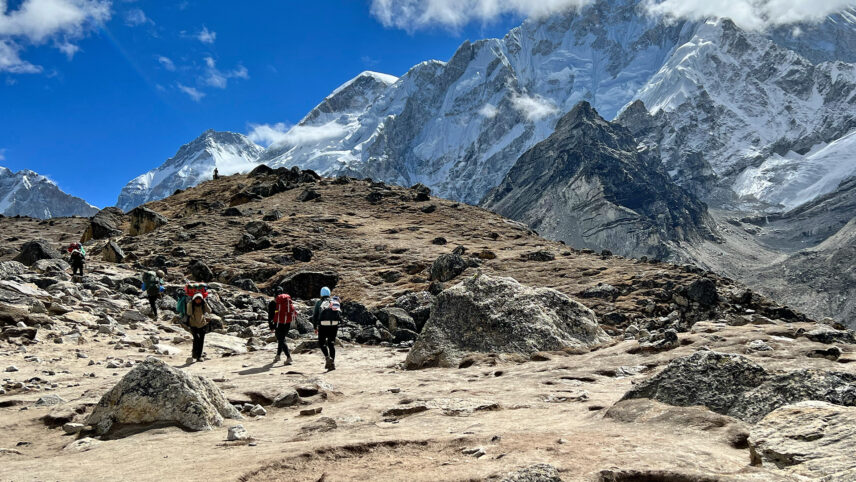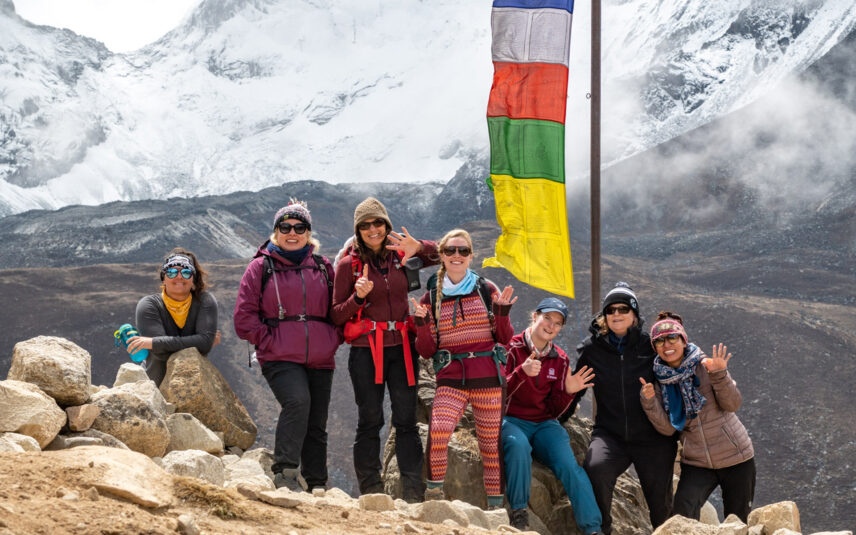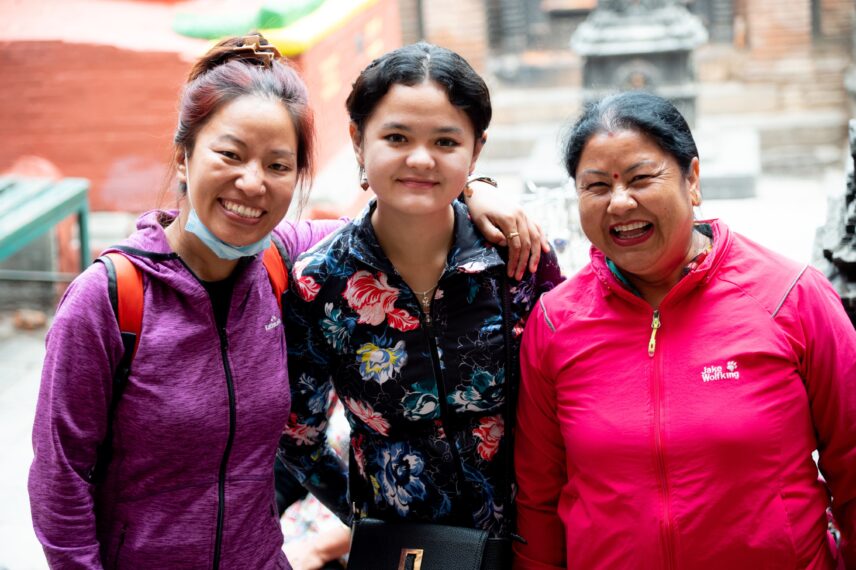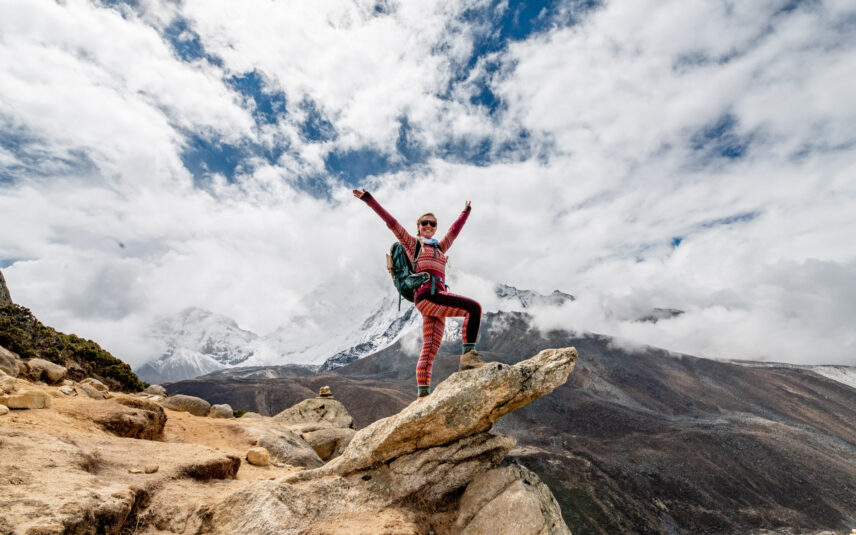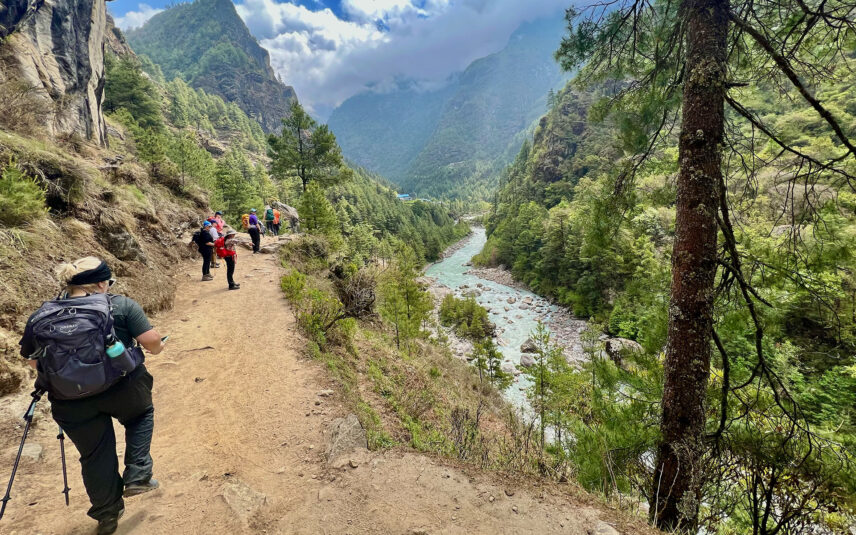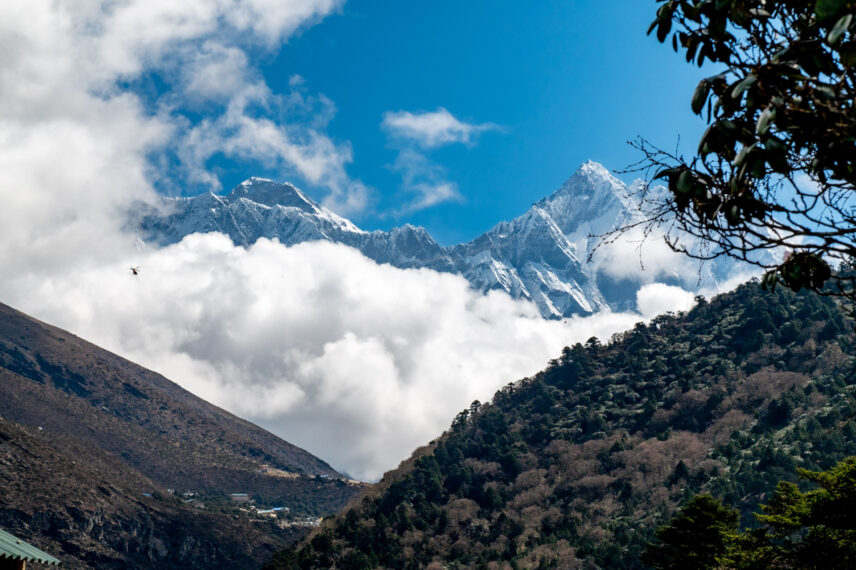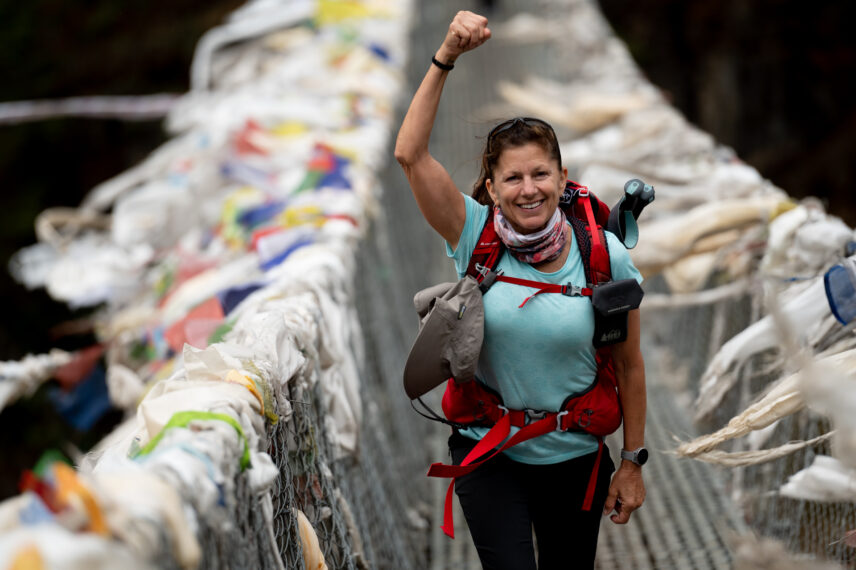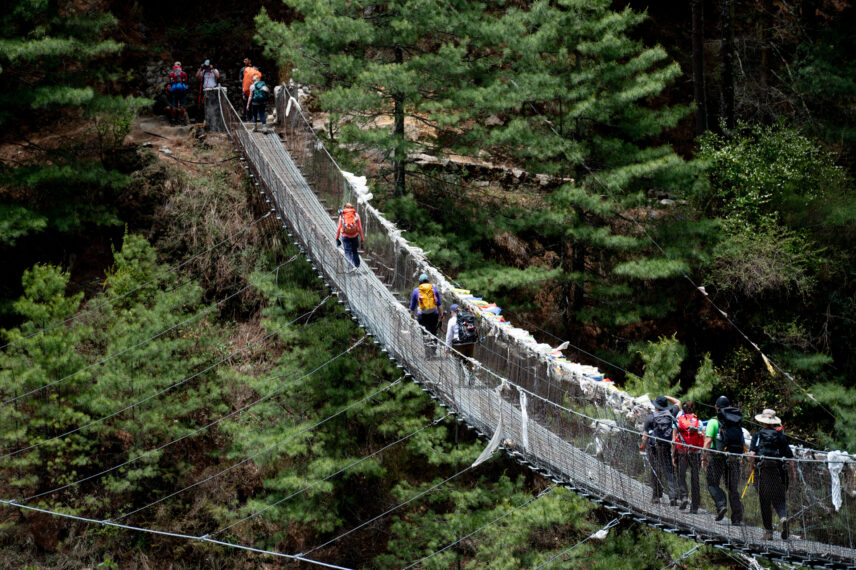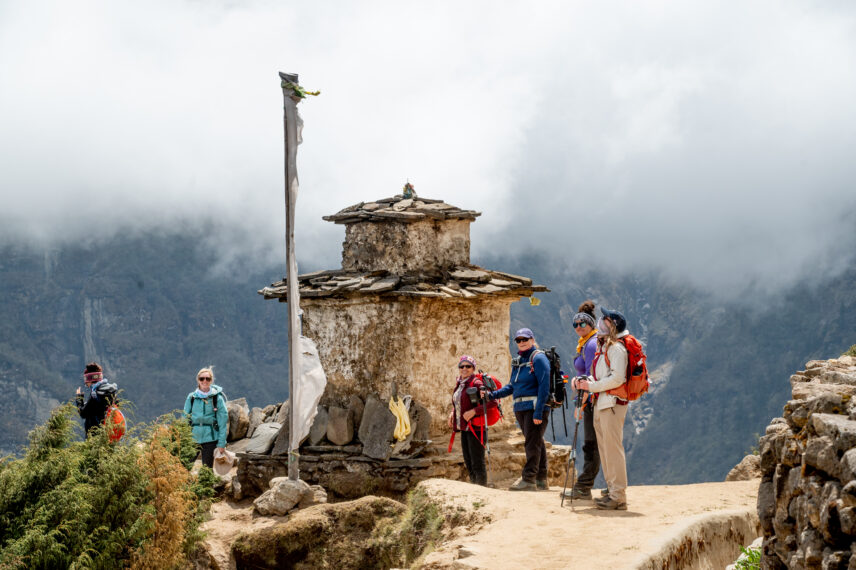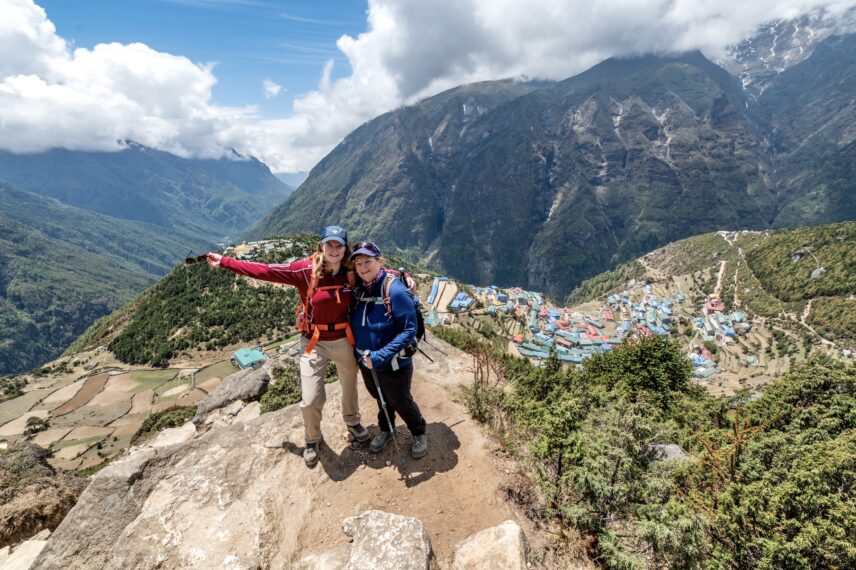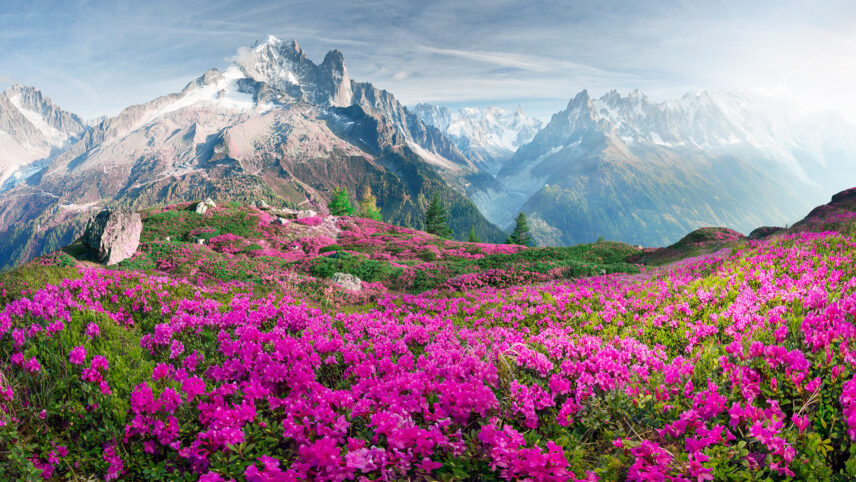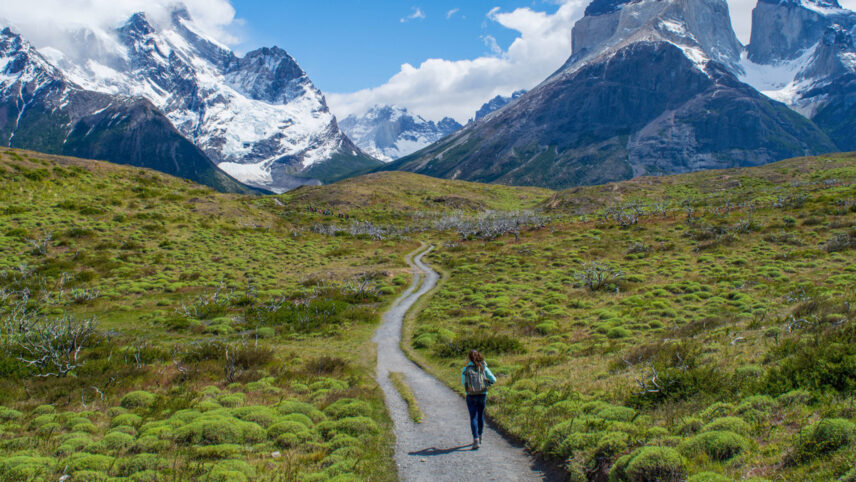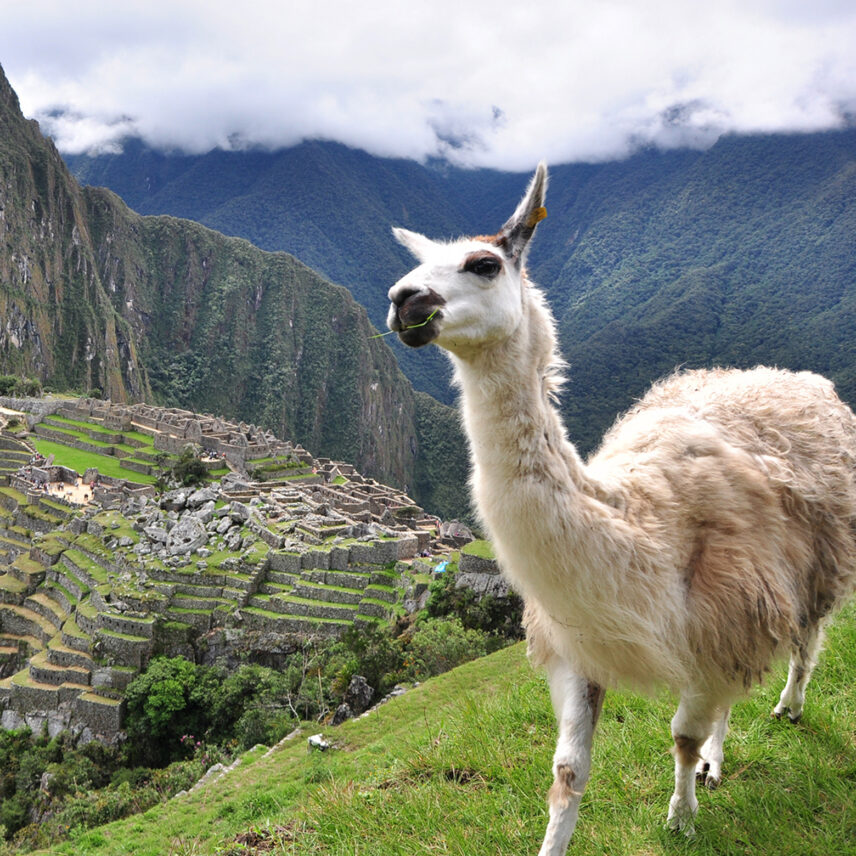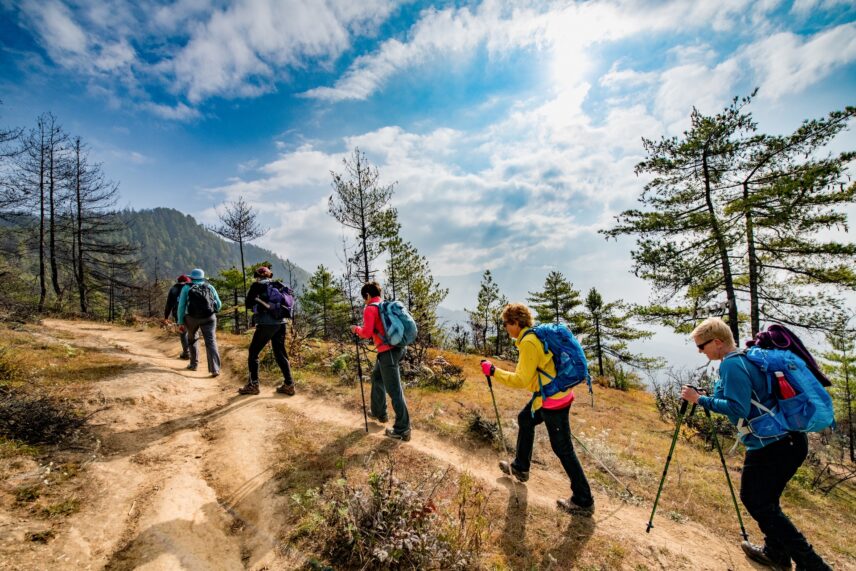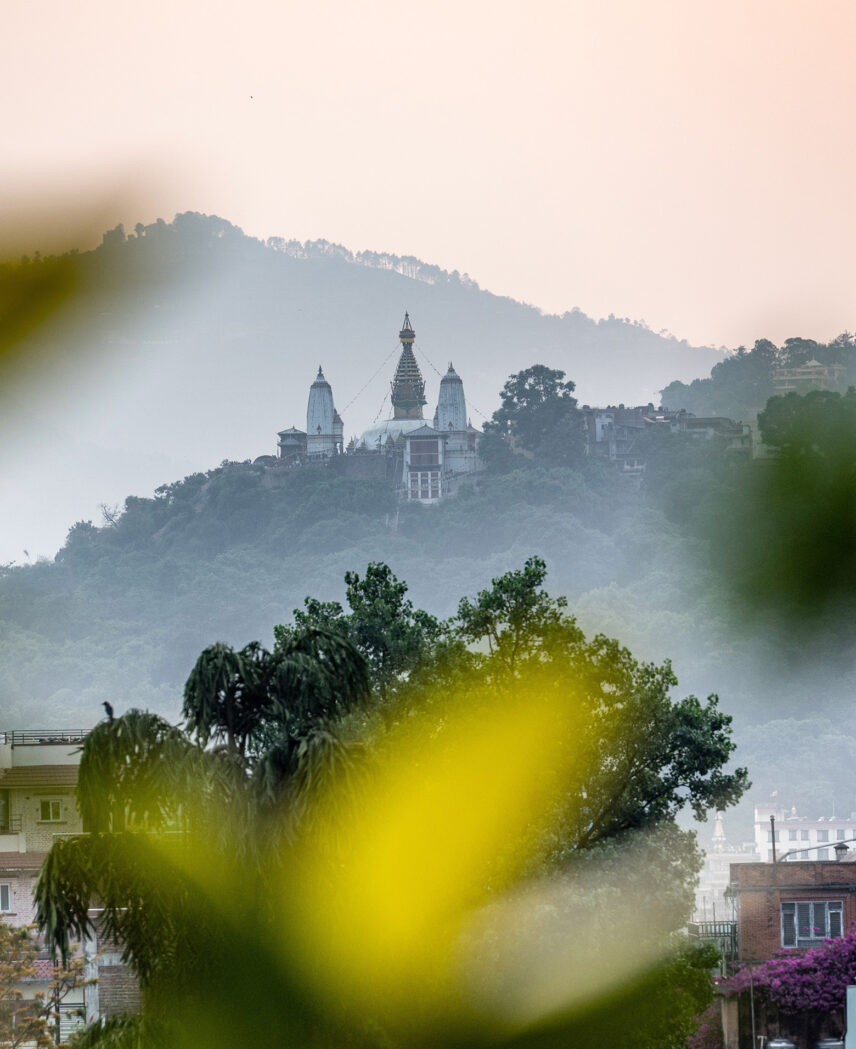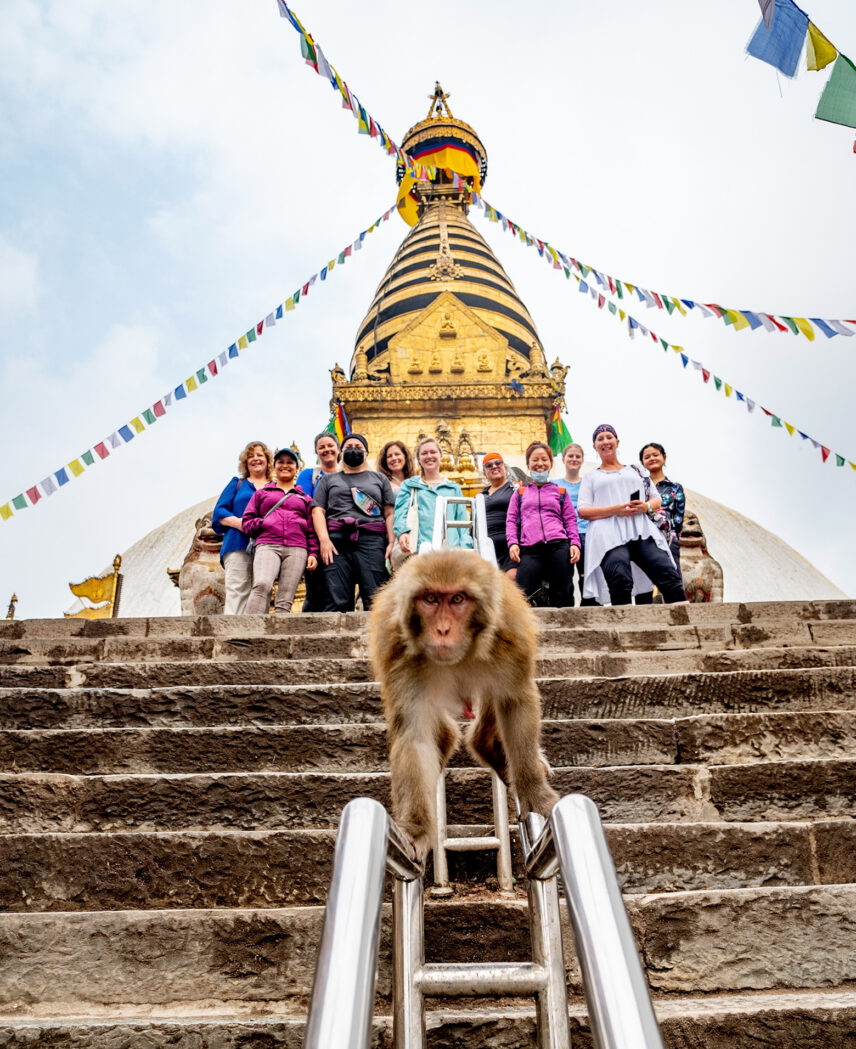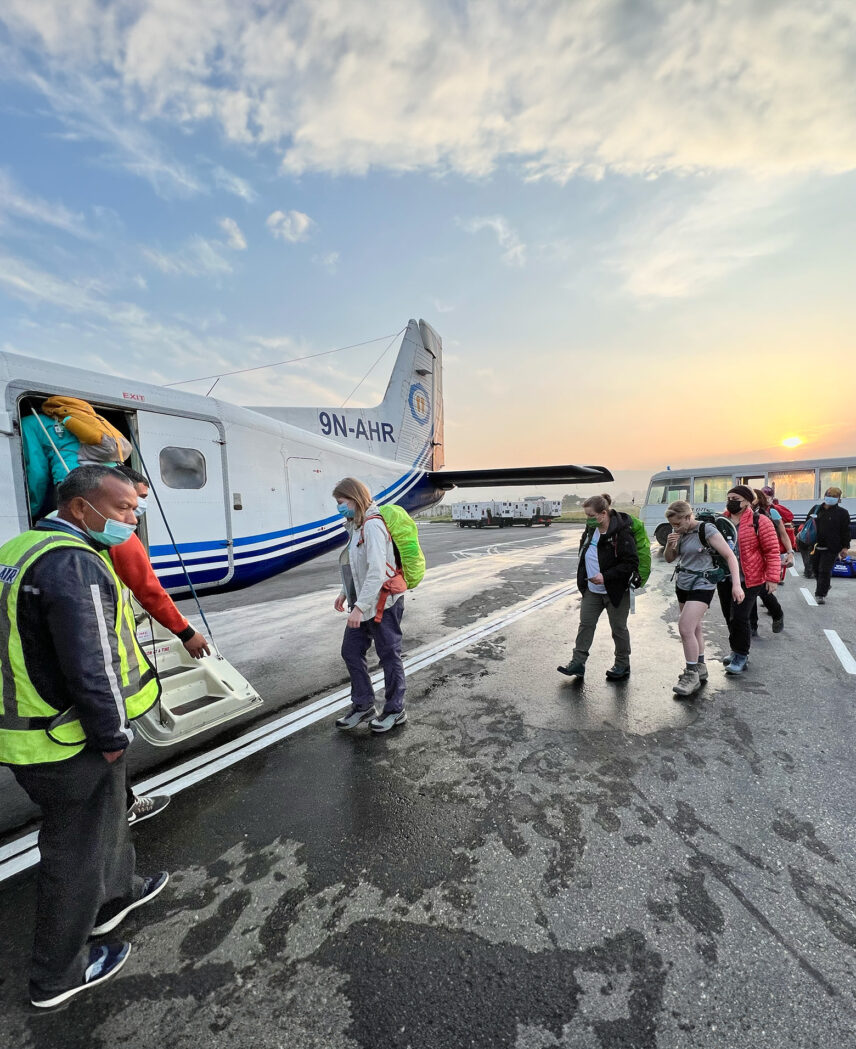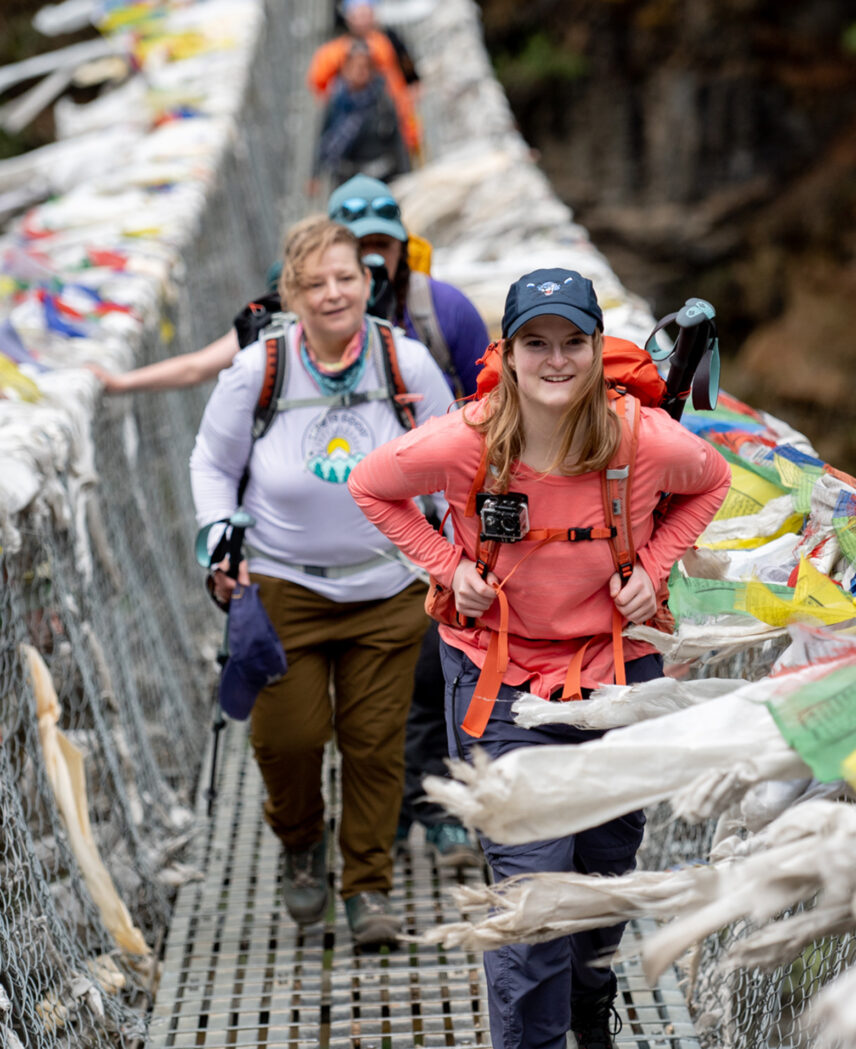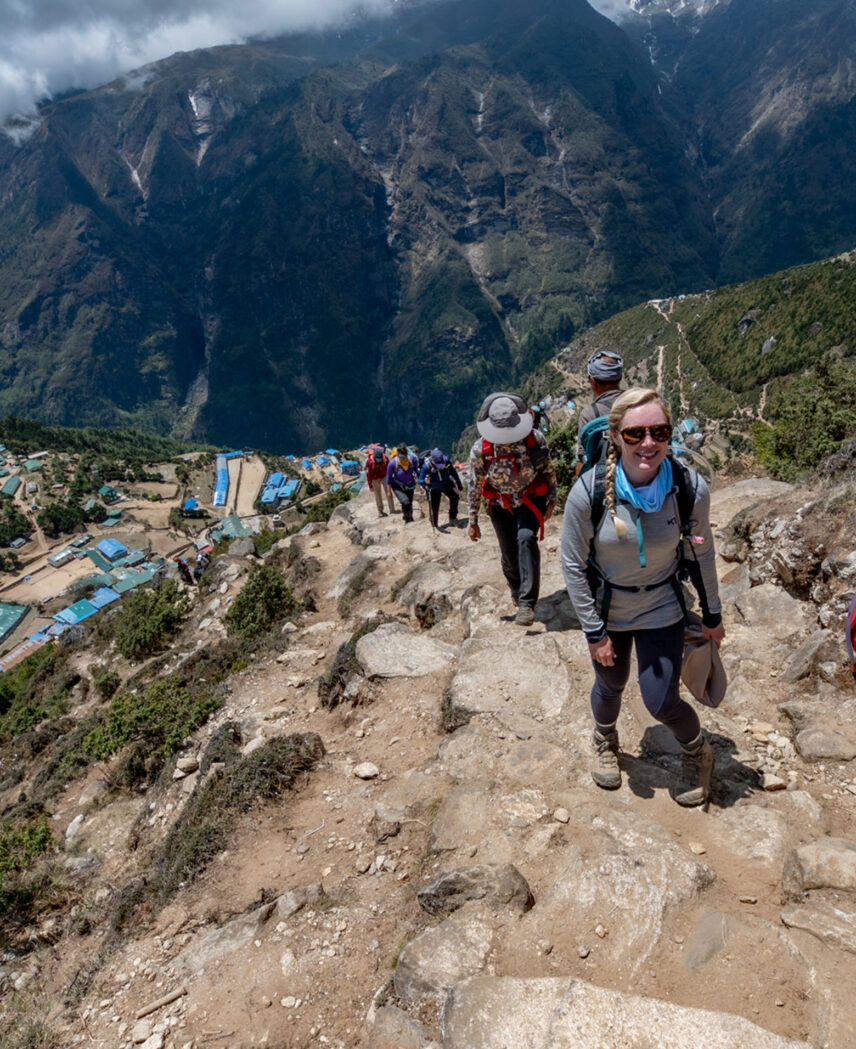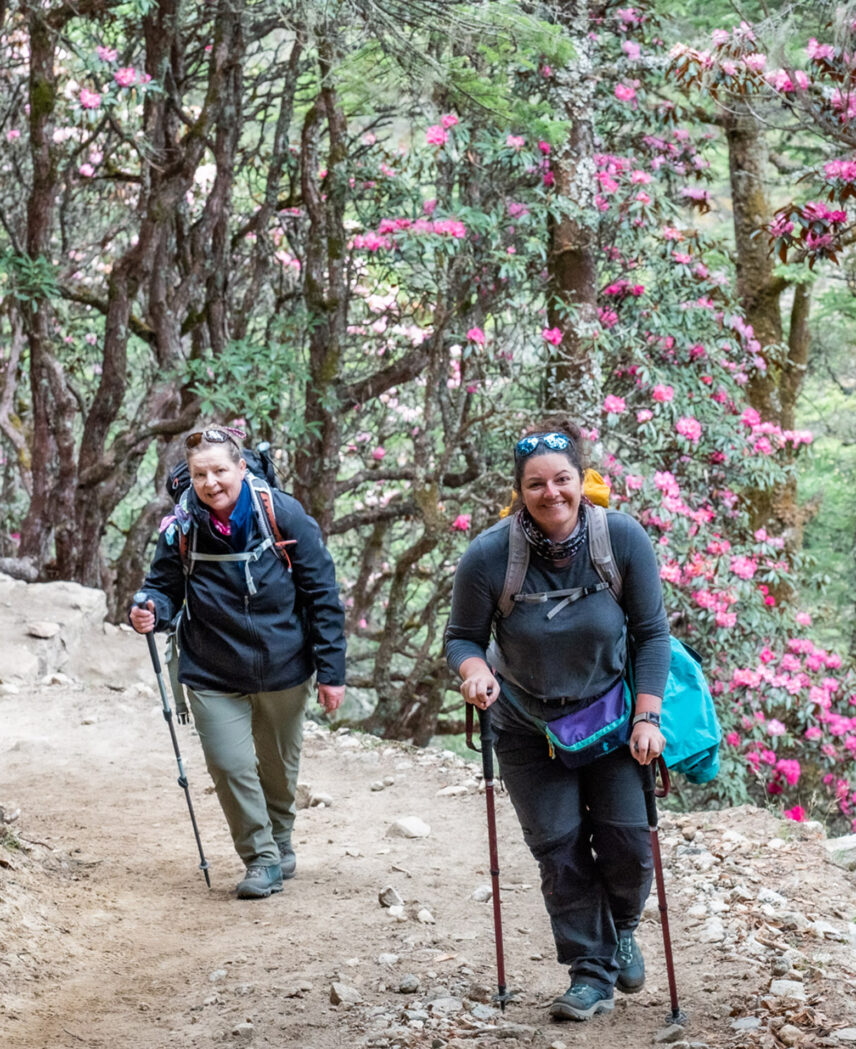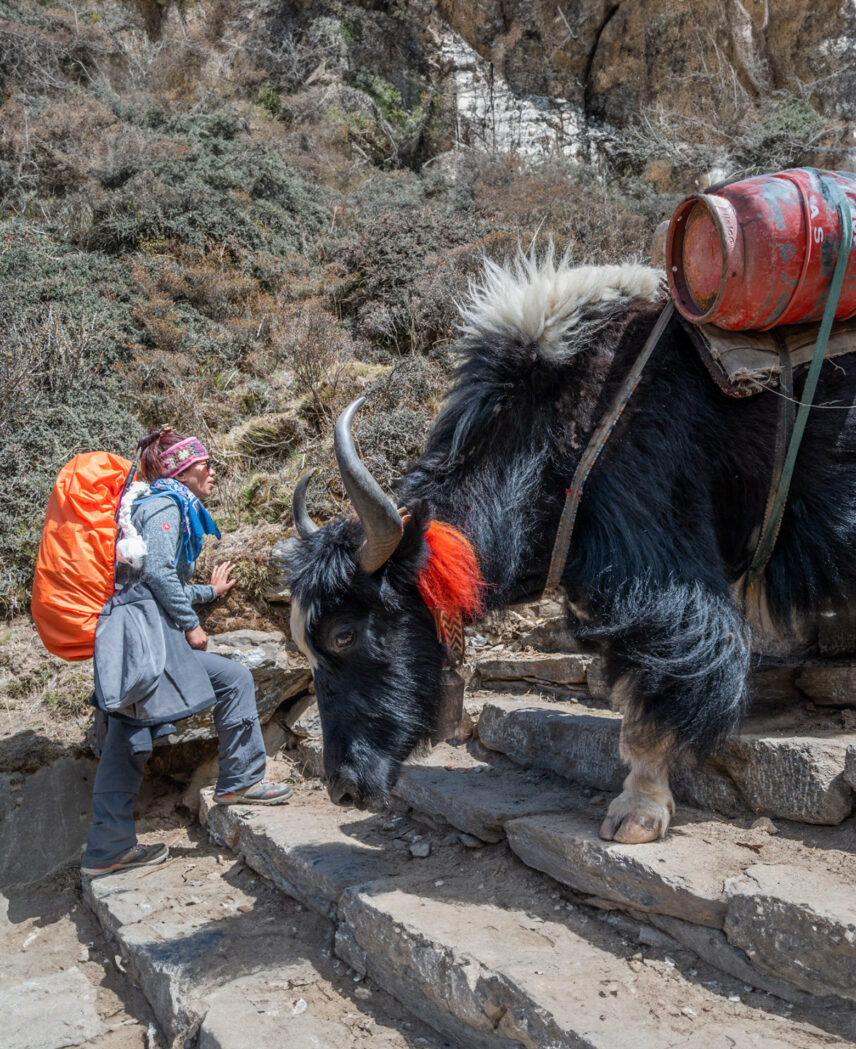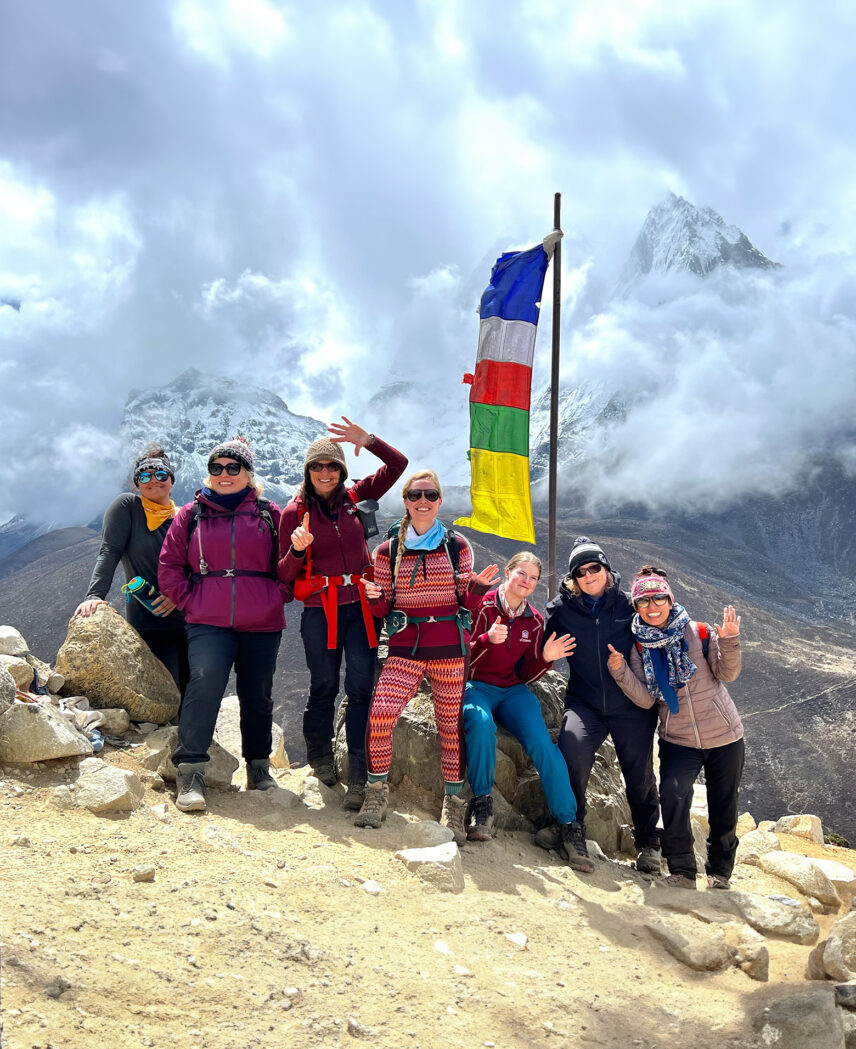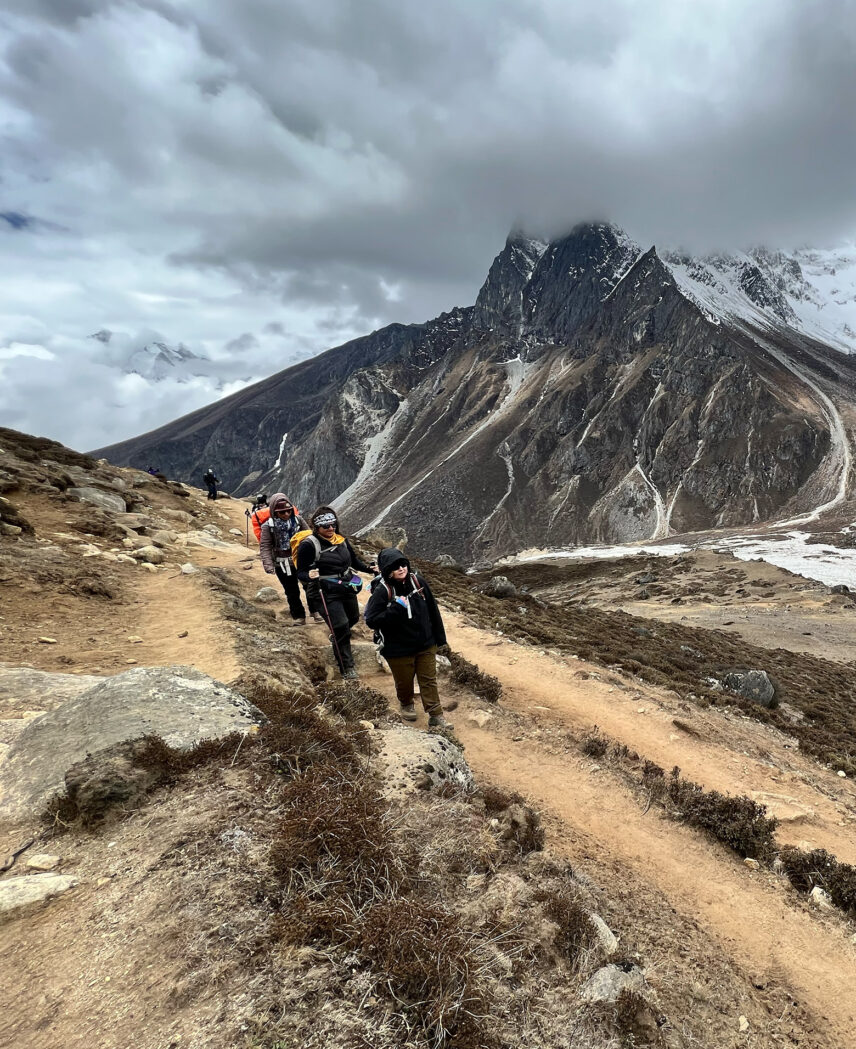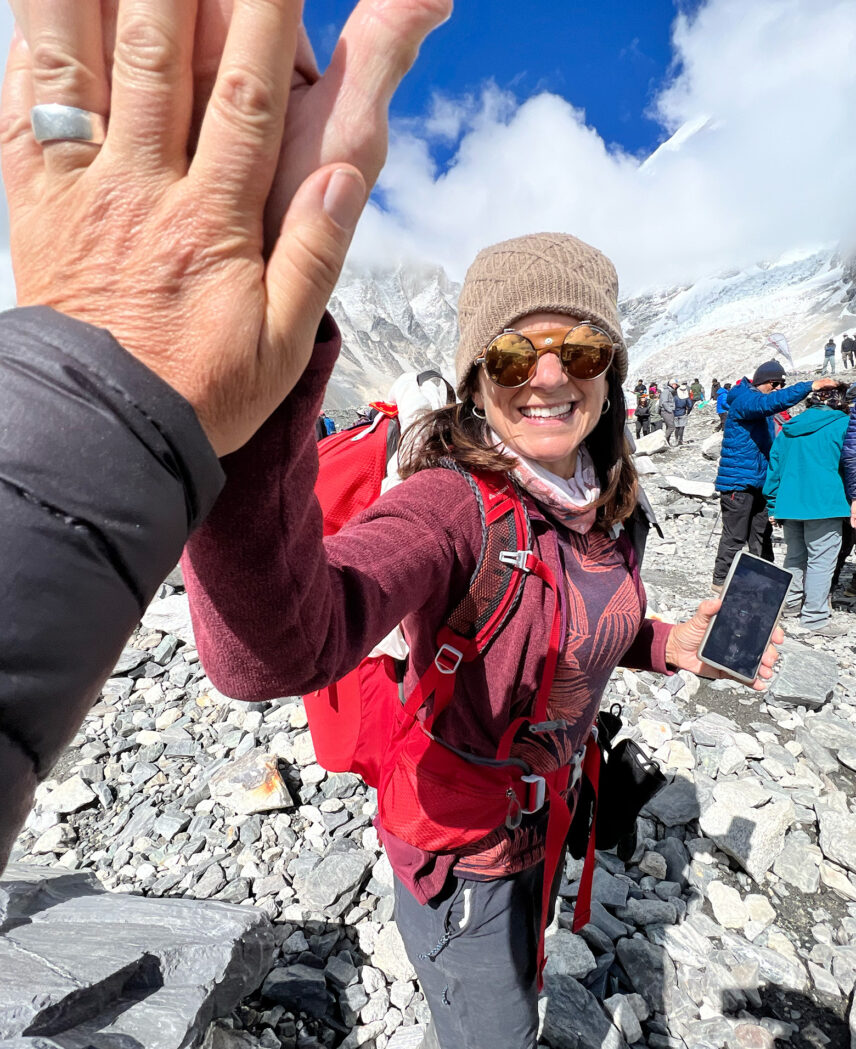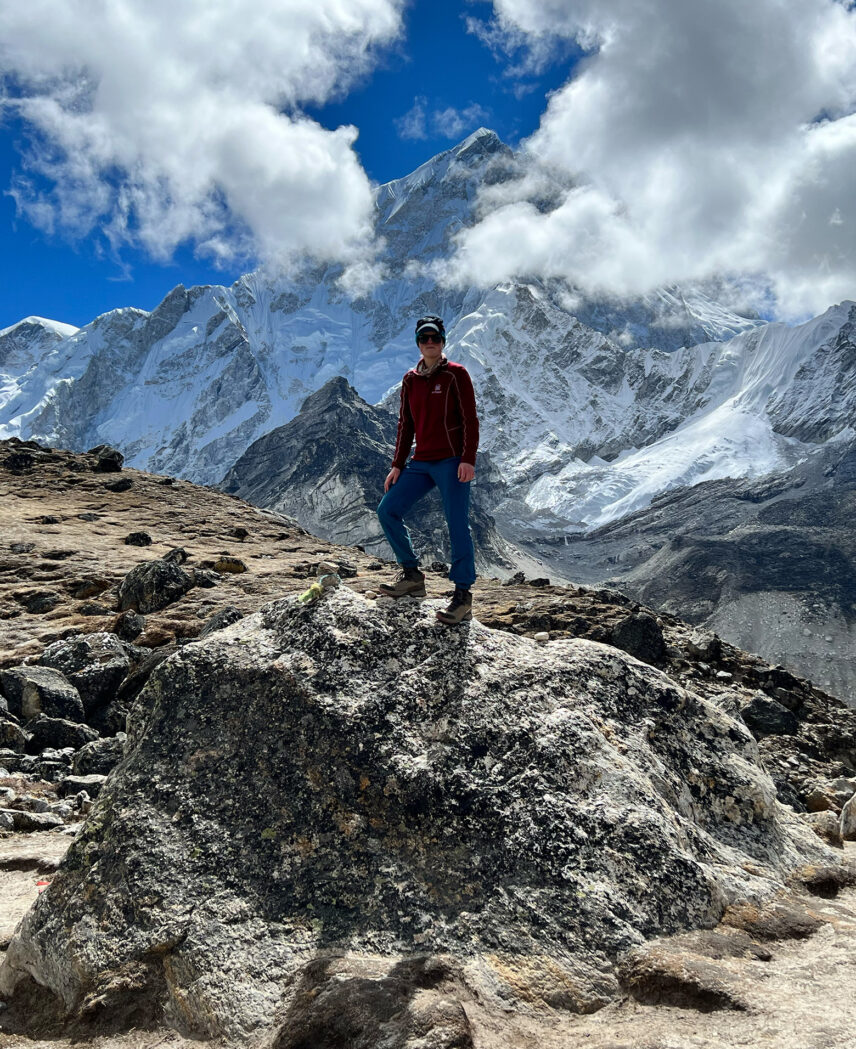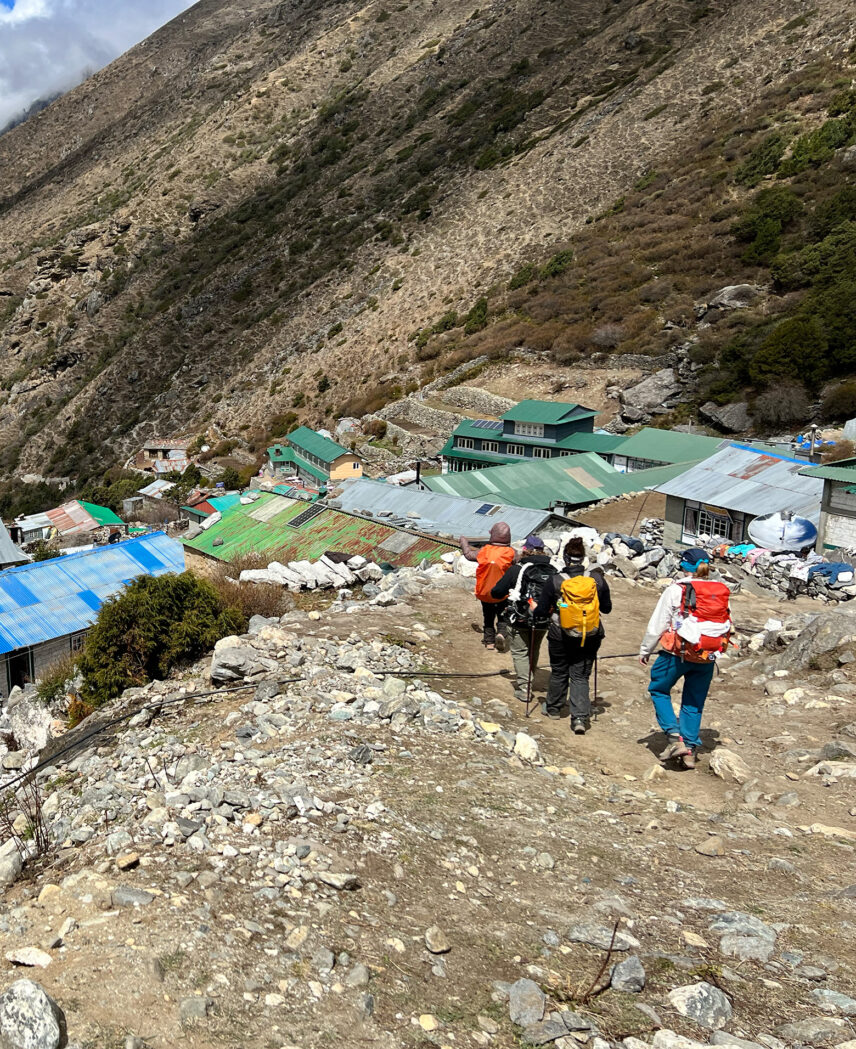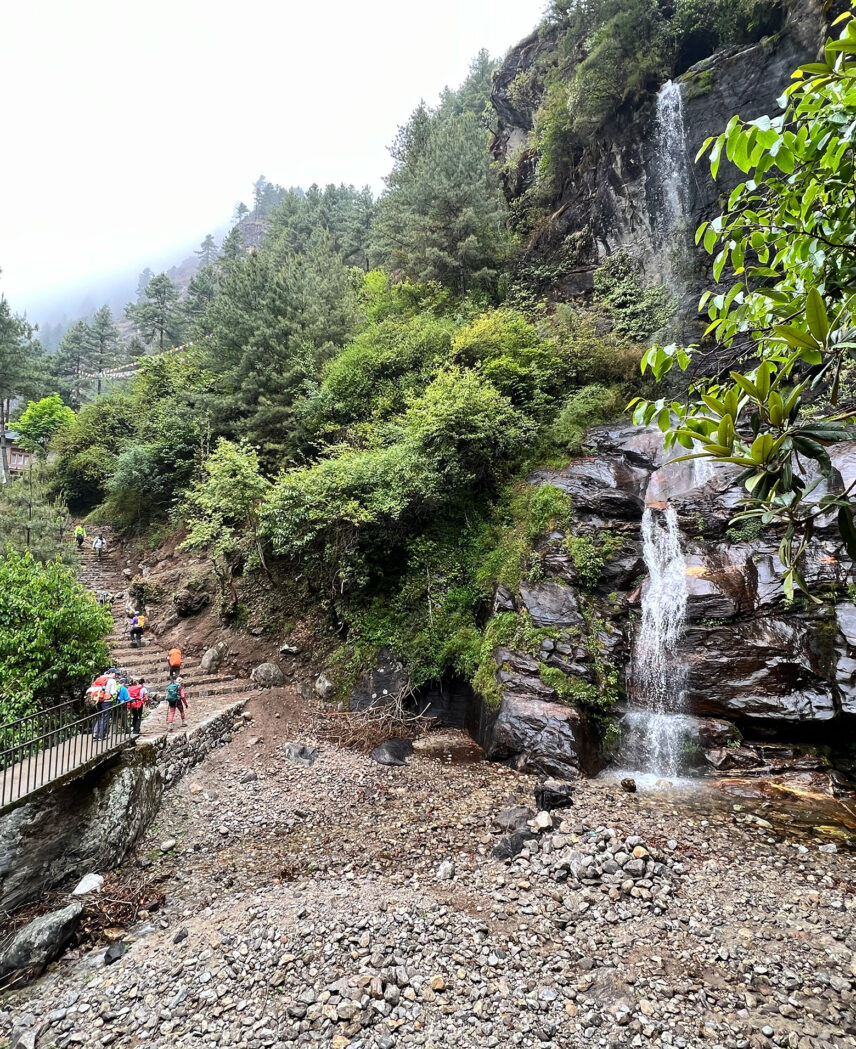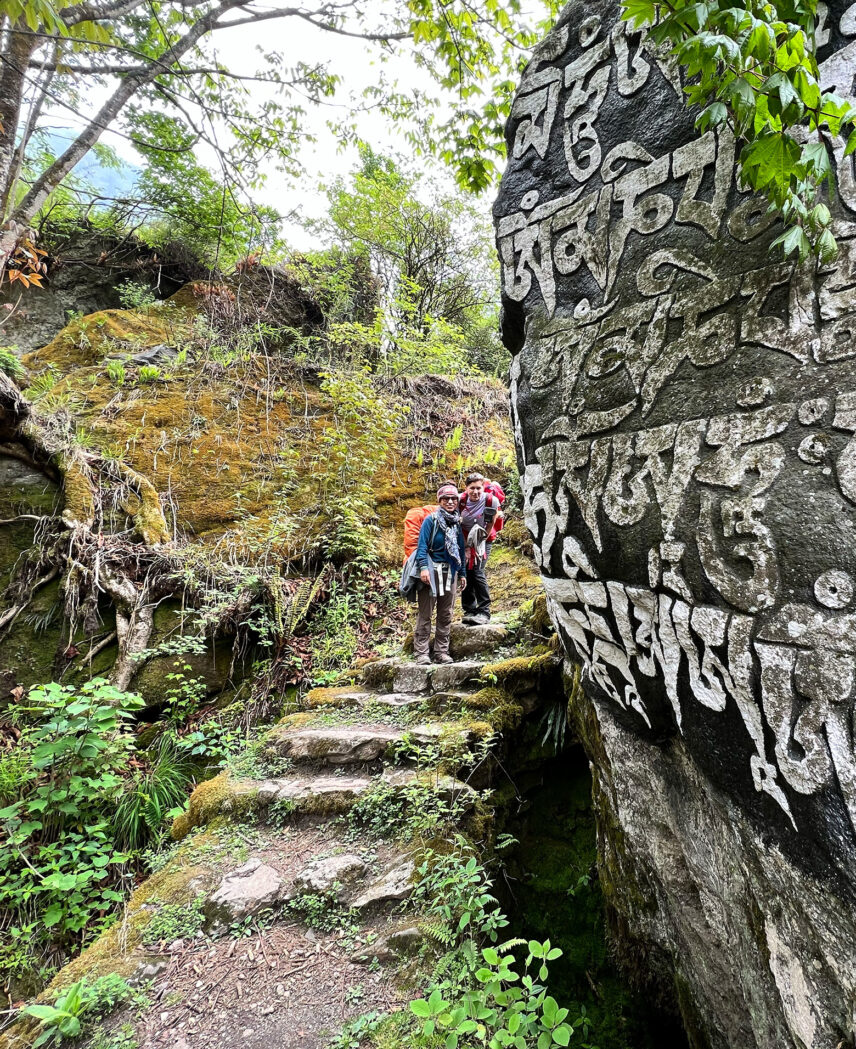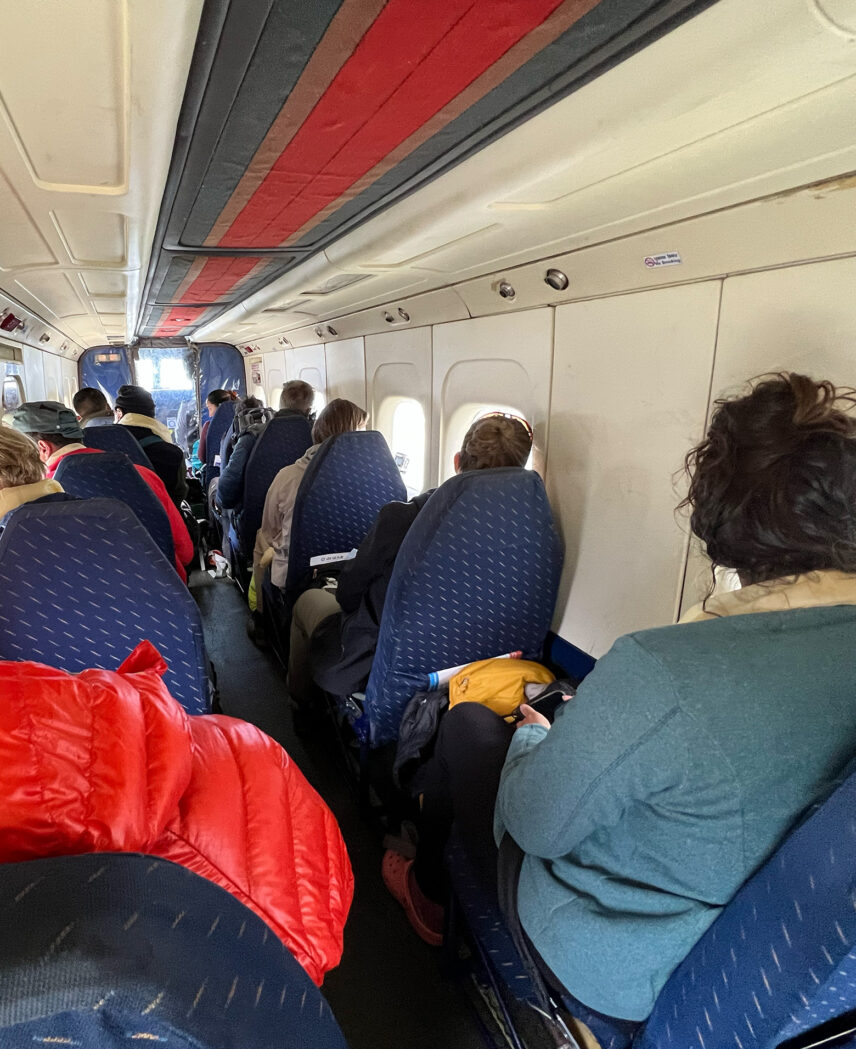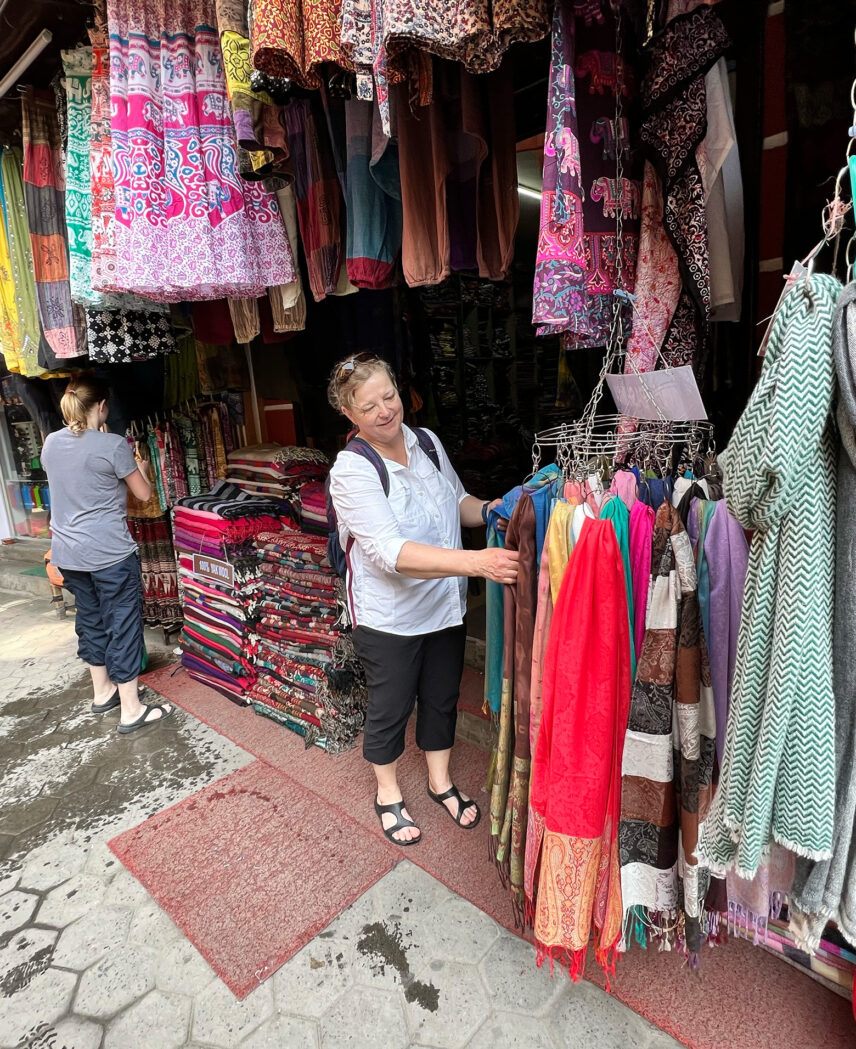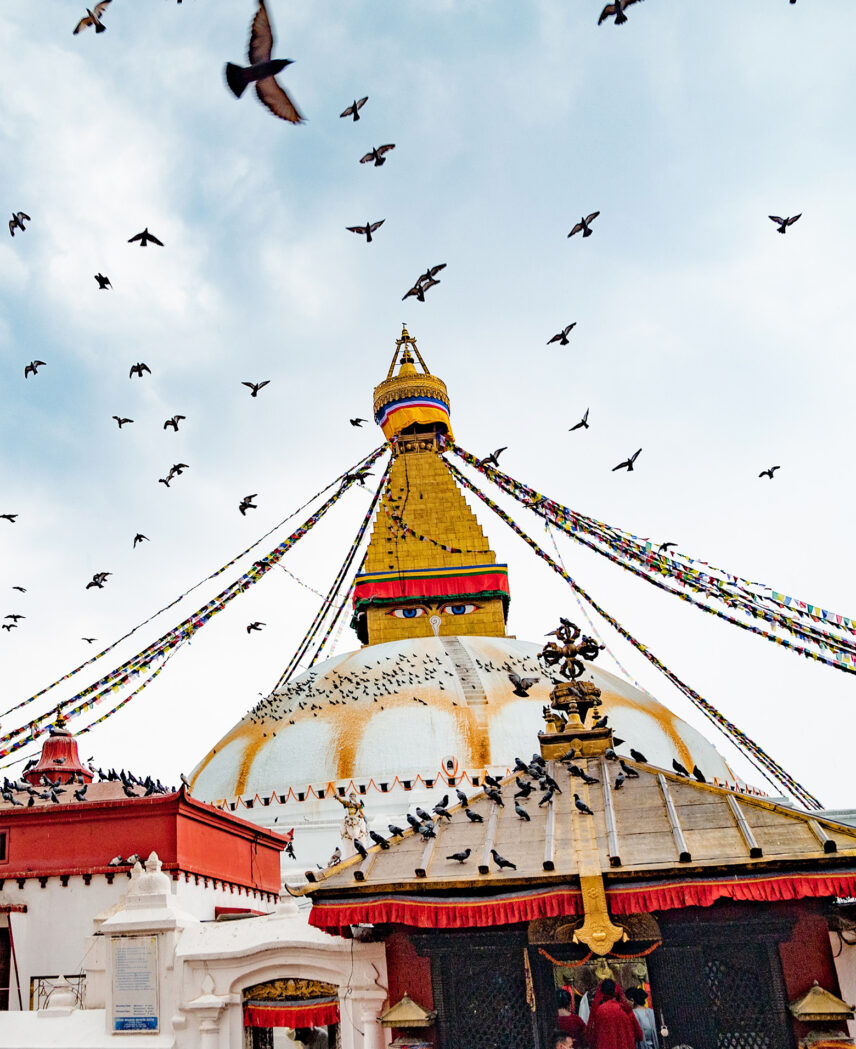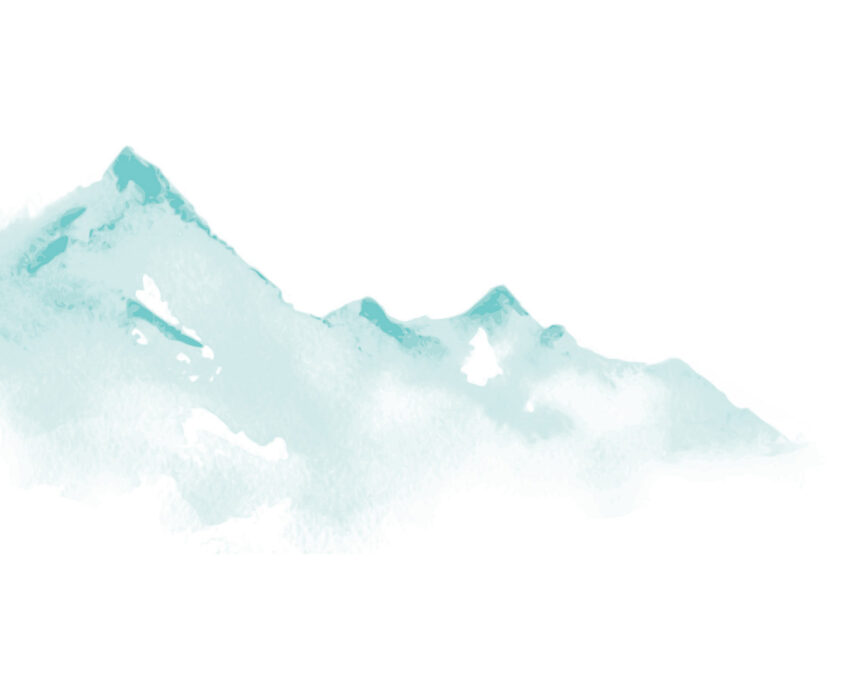
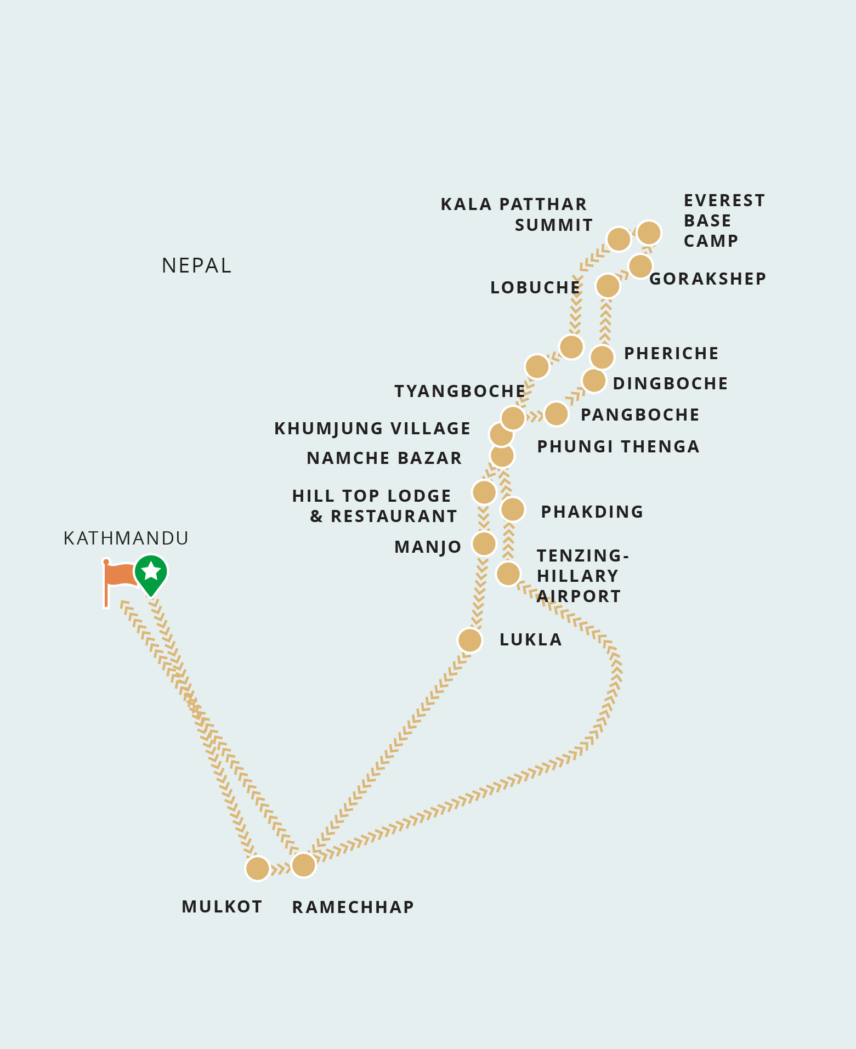
Trip Overview
Departures
Trip Dates + Prices
Duration
18 Days
Activities
Cultural
Hiking
Physical Rating
Challenging
Be the First to Know
Interested in this trip? Get on the list for exclusive information and updates.
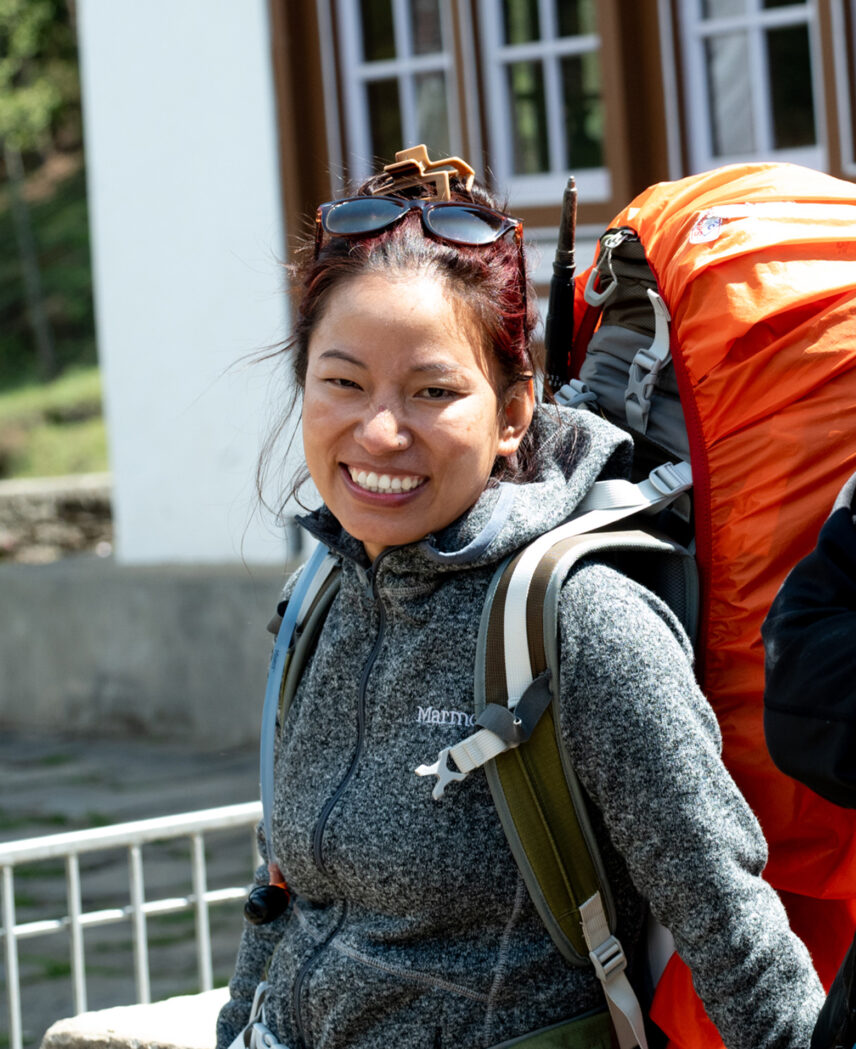
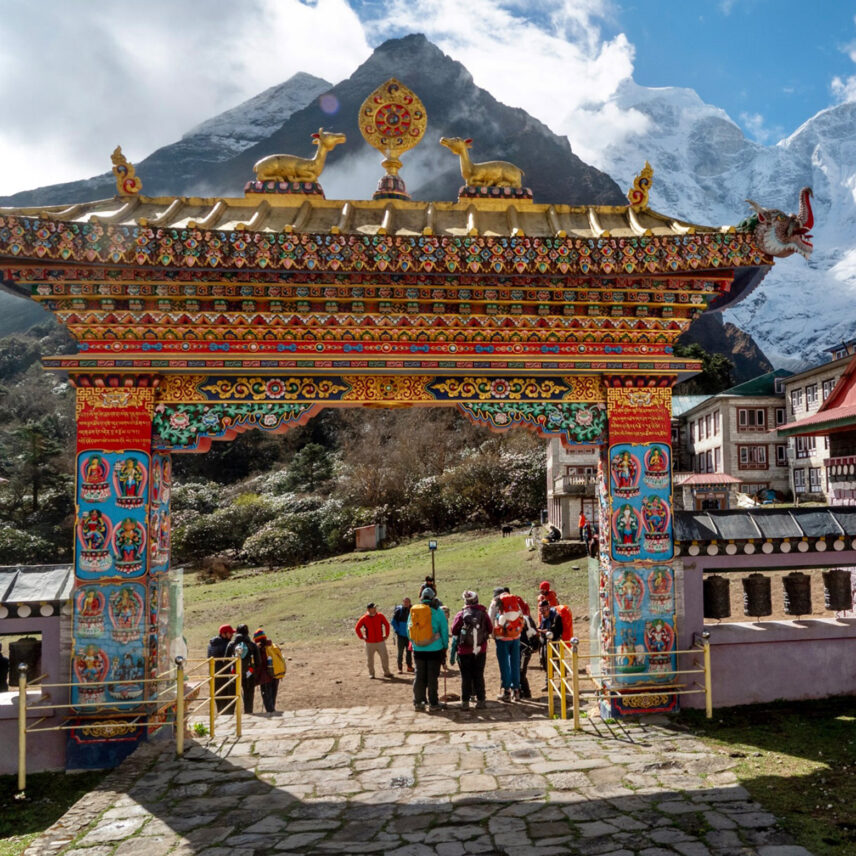
Grit and Grind
Experience the buzz of Kathmandu, the serenity of tiny Nepalese mountain villages and the fever pitch of the candy-colored Namche Bazaar. We visit Buddhist pilgrimage sites and the famed Monkey Temple, where the animated holy rhesus macaque monkeys tumble about under the vibrant prayer flags. The panoramas are on a continuous reel. This is the top of the world and a dream that’s unattainable to many because of the grit, grind and stamina it requires.
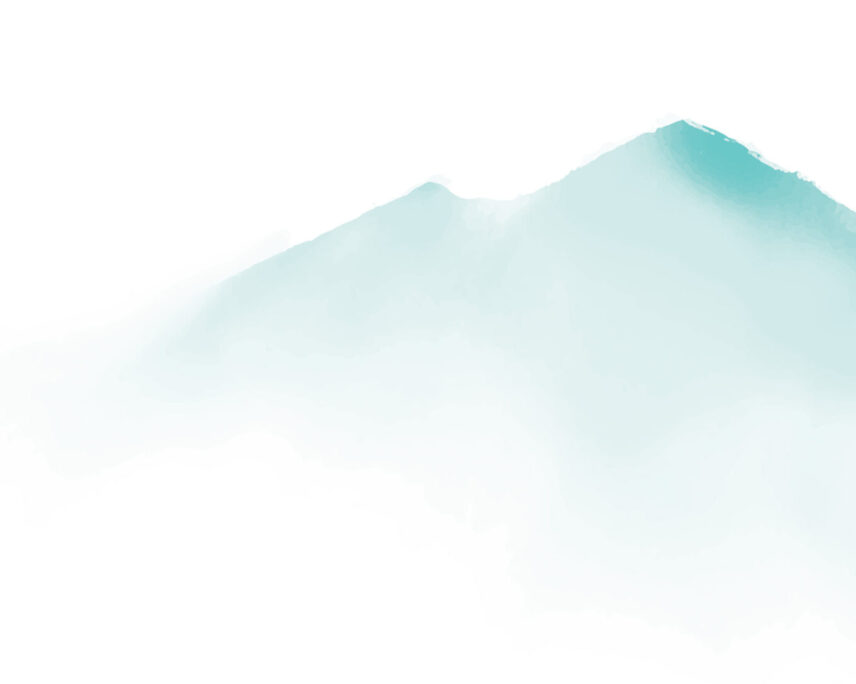
Trek Upward and Inward
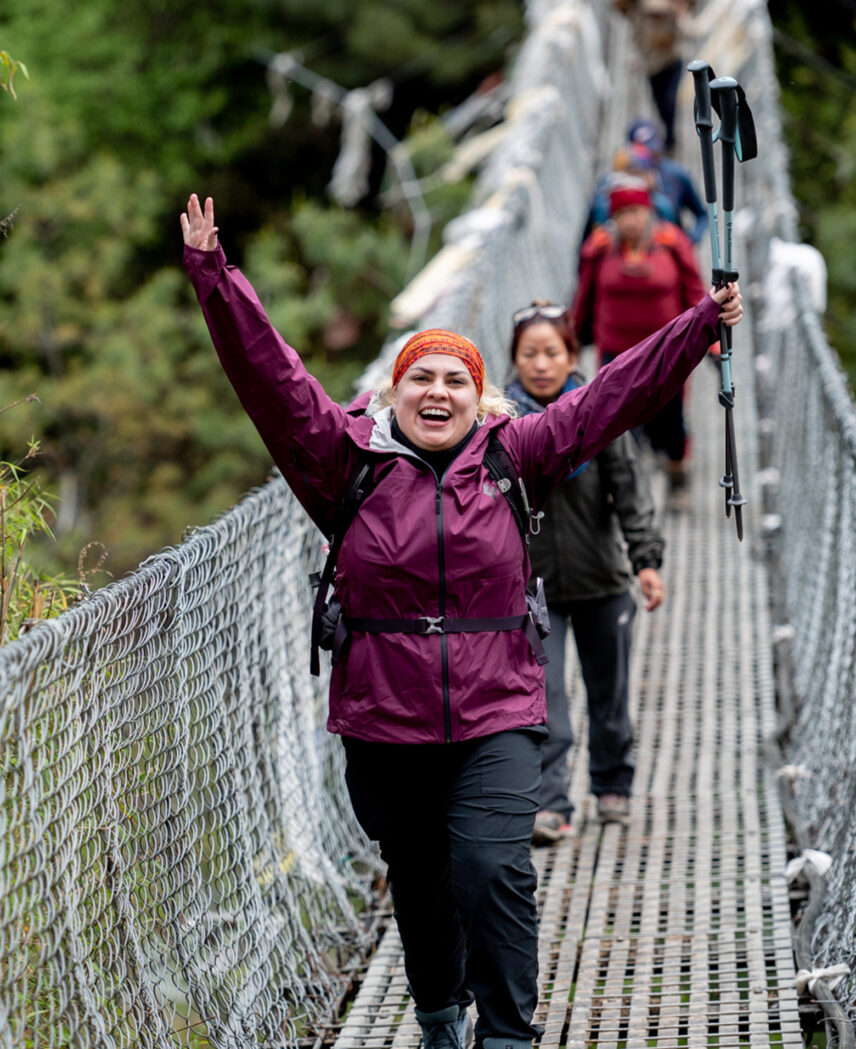
The Ultimate Challenge
This trip will test our mettle on suspension bridges designed to turn your legs into wobbly Jell-O. Test your quivering quads on big elevation gains where the blue sheep graze nonchalantly. If you’re looking for a hardcore physical adventure with spiritual renewal braided in, trekking to Everest Base Camp should be on your radar.
Nepal is a beautiful country of culture, traditions and religions. The people are wonderful and very friendly—I’m so happy I did this trip.”
Gregoria G.
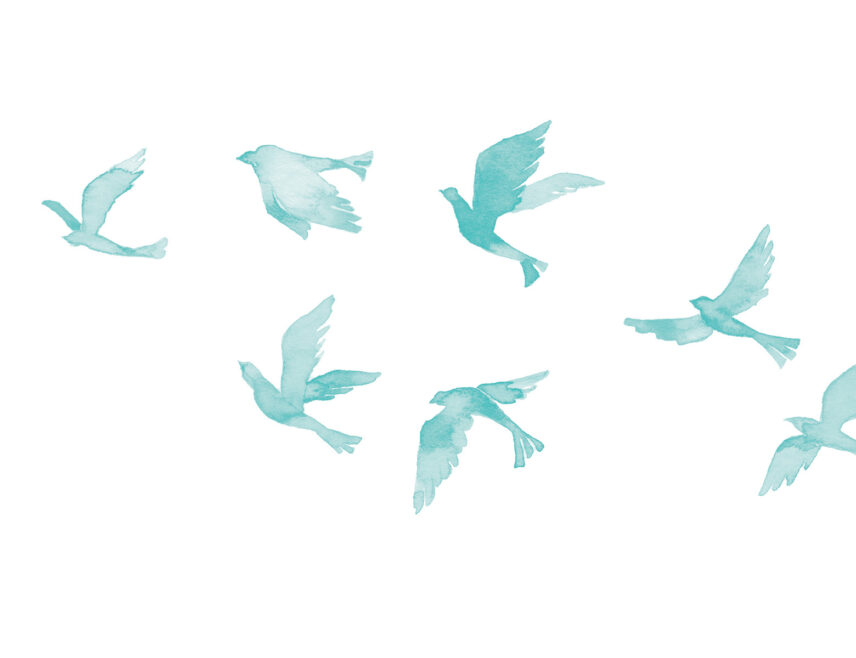
Itinerary
-
Day 1
Arrival in Kathmandu
A Himalayan Hug
Your dream is unfolding! When you arrive at Tribhuvan International Airport (KTM) in Kathmandu, you will feel the rush of altitude immediately (it sits at 4,386 feet/1,337 m elevation). Norbu, our local driver, will meet you at the airport and whisk you directly to the Address Kathmandu Hotel, your first basecamp!
At 4 p.m. meet your fellow steely Wild Women and guides in the hotel lobby for a trip debrief before dinner. Please be aware that food is a spiritual and incredibly precious commodity in Nepal, especially up high in the mountainous area. Access to fresh produce is extremely difficult and therefore cherished. Culturally, it’s highly respectful to only order what you can eat and to avoid wasting any food. Our local guides will share more information over dinner about how we can ensure a culturally sensitive and rewarding experience while in Nepal.
Included Meals
Dinner
Accommodations
The Address Kathmandu Hotel
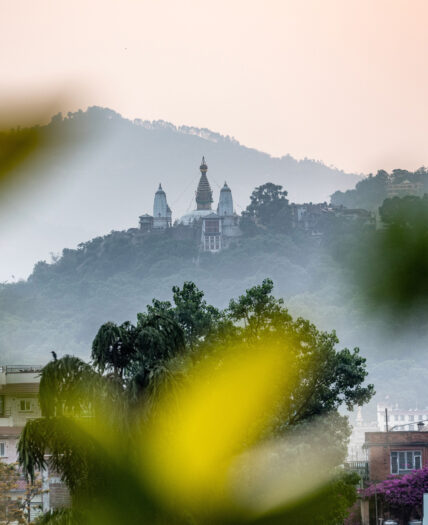
-
Day 2
Kathmandu
The Monkey Temple
Our guide will share stories, bites of history and Nepalese culture as we visit iconic sites like the Buddhist beacon: Boudhanath Stupa. The stupa’s massive mandala makes it one of the largest spherical stupas in Nepal and the world!
The Swayambhunath Temple (known as the “Monkey Temple”) is dramatically located on a hilltop—365 steep steps lead the way. The strings of prayer flags and animated monkeys who call this temple home make for an unforgettable encounter.
In the city center, we visit the former royal palace, pagoda temples and courtyards of Patan Durbar Square, which is a designated UNESCO Heritage Site. After absorbing a big gulp of history we have lunch in Patan, the famed city of artisans.
In Mulkot, we check into our accommodations, go for an evening walk and then repack for our trek ahead before dinner. Any additional, unnecessary luggage can be left safely.
Included Meals
Breakfast, lunch and dinner
Accommodations
Mulkot Hotel
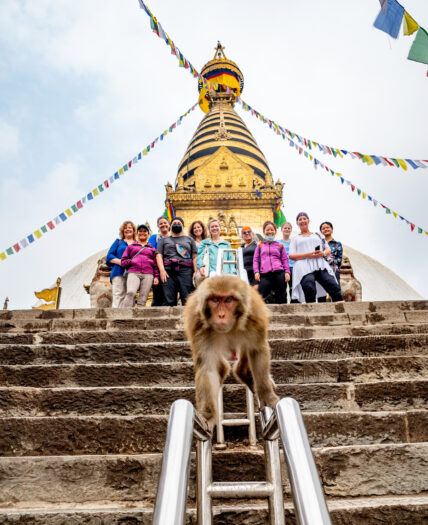
-
Day 3
Lukla
Mother Goddess of the World
We’ll have an early start (4 a.m.) in order to grab the first flight to Lukla (6 a.m.) out of Ramechhap Airport.
Upon arrival in Lukla, a porter will be on standby to collect and organize our luggage (to transport to Hotel Khumbu Resort) while we have breakfast.
Our Everest trek officially begins with three hours of downhill walking to our lodge in the town of Phakding where we will dream of Chomolungma (the Tibetan name for Everest), the “Mother Goddess of the World.”
We will be sharing the trails with many charged-up trekkers, locals, mules and dzos (a cross between a yak and a cow). This is day one of thirteen incredible days spent trekking!
Included Meals
Breakfast, lunch and dinner
Accommodations
Lodge in Phakding
Travel
*Please note that flights into Lukla are subject to many factors and if the airlines are not operating flights by 1 a.m., we must be ready to pay up to an additional $650 US (credit cards accepted) for a helicopter flight to maintain the scheduled itinerary.
The Trek
- Trek Route: Lukla (elevation: 9,449 feet/2,880 m) to Phakding (elevation: 8,563 feet/2,610 m)
- Trek Distance: 5.6 miles/9 km
- Elevation Loss: About 885 feet/270 m
- Elevation Gain: About 623 feet/190 m
- Estimated Hiking Time: 3–4 hours
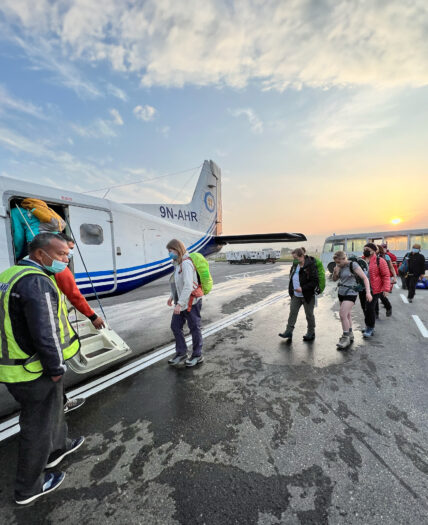
-
Day 4
Phakding to Namche Bazaar
Crossing Bridge after Bridge
Today’s section is the one we hear the most about. The long, consistently steep inclines as well as a number of very high suspension bridges are prominently featured in movies and documentaries.
In the morning, we follow the Dudh Koshi river, with gradual ups and downs until Jorsalle. Here, we’ll enter Sagarmatha National Park, a protected area that is home to elusive species like the snow leopard, musk deer and red panda.
After lunch, our trek continues to the Hillary suspension bridge (410 feet/125 m) to climb up to Namche Bazaar. Today’s mantra is “steady, steady” or “bsatari, bsatari.”
It’s important that we climb at our own rhythm and pace as this quad-quivering grueling climb takes about three hours. Tonight is free range—we can wander the Namche Bazaar, lean into some yoga or simply meditate.
Included Meals
Breakfast, lunch and dinner
Accommodations
SherpaLand Hotel
The Trek
- Trek Route: Phakding (elevation: 8,563 feet/2,610 m) to Namche Bazaar (elevation: 11,595 feet/3,535 m)
- Trek Distance: About 5.6 miles/9 km
- Elevation Gain: About 3,032 feet/925 m
- Estimated Hiking Time: 5–6 hours
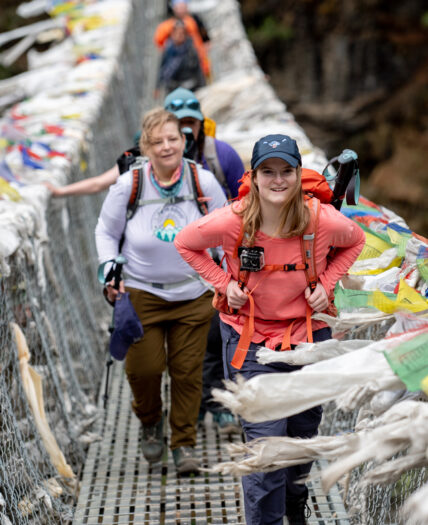
-
Day 5
Namche Bazaar
Acclimatization in Namche Bazaar
A typical acclimatization day consists of a short hike around the valley to adjust to the increasingly thin air, then returning to a lower elevation (Kyangjuma) to sleep.
Today’s hike is an exploration hike up towards the Sherpa people’s historic settlement, which is known as Khumjung village. On this hike, we will reach up to 12,713 feet (3,875 m) at Shyangboche La before we descend to 12,434 feet (3,790 m) at Khumjung village. In the village, we embrace the serenity of the monastery.
We have lunch in the village before descending down to Kyangjuma (11,811 feet/(3,600 m). After we arrive, we can indulge in free time and absorb the views of Ama Dablam, Thamserku, Kangtega and Taboche. If Mother Nature plays nice, on a clear day we may be privy to a dazzling sunset show over these mighty peaks.
Included Meals
Breakfast, lunch and dinner
Accommodations
Amadablam Guest House in Kyangjuma
The Trek
- Trek Route: Namche Bazaar (elevation 11,595 feet/3,410 m) to Shyangbouche Hill (elevation 12,795 feet/3,900 m)
- Trek Distance: 3 miles (5 km) return—nothing like yesterday’s hamstring tenderizer!
- Elevation Gain: About 525 feet (160 m)
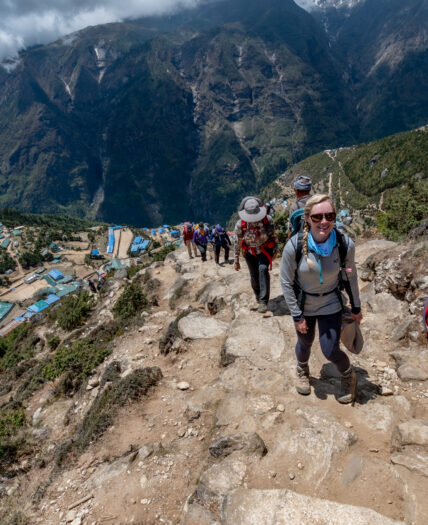
-
Day 6
Kyangjuma to Tengboche
Super Scenic
The early bird gets the worm and a startling sunrise view over the Amadablam and surrounding jagged peaks! We enjoy a super scenic breakfast and drink in the view of these peaks over steaming cups of tea. After breakfast, we embark on a gentle descent down to Phungi Thenga. Here, we take a short tea break to revive before we trek to Tengboche, where we stop for lunch (we’ll also be spending the night in Tengboche). We rest and digest for a bit before visiting the local monastery.
In the evening, we take a short acclimatization hike. Depending on the day, we may have the opportunity to observe a prayer ceremony in the evening or, possibly in the morning.
Included Meals
Breakfast, lunch and dinner
Accommodations
Hotel Tashidelek in Tengboche
The Trek
- Trek Route: Kyangjuma (elevation: 11,811 feet/3,600 m) to Tengboche (elevation: 12,628 feet/3,850 m)
- Trek Distance: 3.72 miles/6 km
- Elevation Gain: 935 feet/285 m
- Estimated Hiking Time: 4 hours
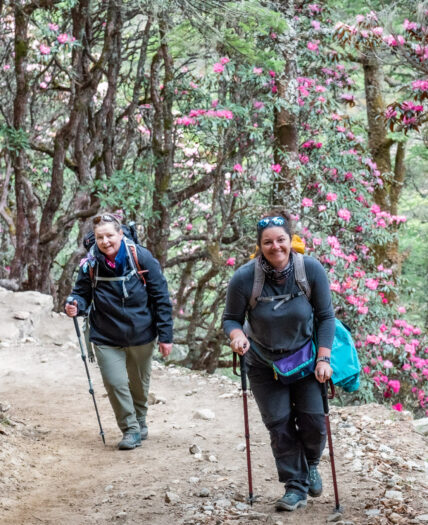
-
Day 7
Tengboche to Dingboche
Monastery and Mountain Peaks
We are gently stirred this morning by the reverberating prayer music from the monastery as the marmalade sun rises on Langur Himal, Mt. Everest and the surrounding peaks. After breakfast, our trail will take us downhill and continue very gradually up and down hills before crossing the river. We then head uphill towards Pangboche and follow the gradient upwards towards the Imja Valley where the mighty Island peak will magnetically pull us ahead. We arrive one hour later in Dingboche.The views will become more expansive with vast valleys and winding streams ribboning far below us. Spectacular surprise views seem to sit in wait around each corner. There will be some wide open flat areas that will offer relief for weary hikers with the incentive of magnificent landscapes and hot tea ahead.
Included Meals
Breakfast, lunch and dinner
Accommodations
Hotel Good Luck in Dingboche
The Trek
- Trek Route: Tengboche (elevation: 12,628 feet/3,850 m) to Dingboche (elevation: 14,268 feet/4,350 m)
- Trek Distance: 9 miles/14.5 km
- Elevation Gain: 1,640 feet/500 m
- Estimated Hiking Time: 6 hours (give or take a few selfies)
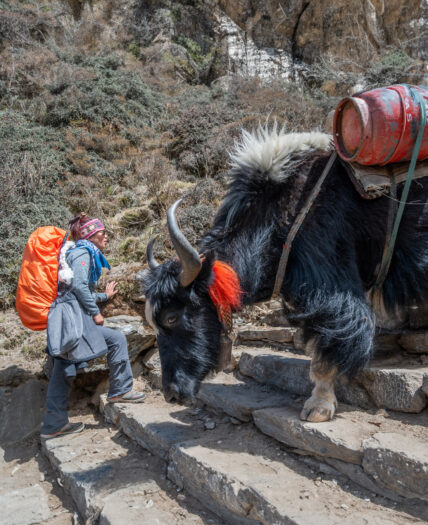
-
Day 8
Dingboche
Acclimatization Day
Our focus will be another vital day of acclimatization. We embark on a three-hour hike to a lookout above Dingboche, where we will aim to reach a height of 16,076 feet (4,900 m) gaining 1,640 feet (500 m).
The drop in oxygen content in the air is palpable on the uphill sections of the trail. There’s a reason why Jon Krakauer called his book Into Thin Air! Luckily, there are no balloons to blow-up for a birthday party.
From our summit, we can see Makalu, the fifth highest mountain, as well as the stretched out ranges of Langur Himal (which is connected between Mt. Nuptse and Mt. Lhotse).
Enjoy the life-affirming 360-degree mountain views! We return to Dingboche and have the rest of the day to play. Relax, doodle, drink endless cups of tea and definitely have a sweet fix at the bakery.
Included Meals
Breakfast, lunch and dinner
Accommodations
Hotel Good Luck in Dingboche
The Trek
- Trek Route: Dingboche (elevation: 14,268 feet/4,350 m) to the lookout (16,076 feet/4,900 m)
- Trek Distance: 1.9 miles (3 km)
- Elevation: 1,640 feet/500 m of ascent and descent
- Estimated Hiking Time: 3–4 hours
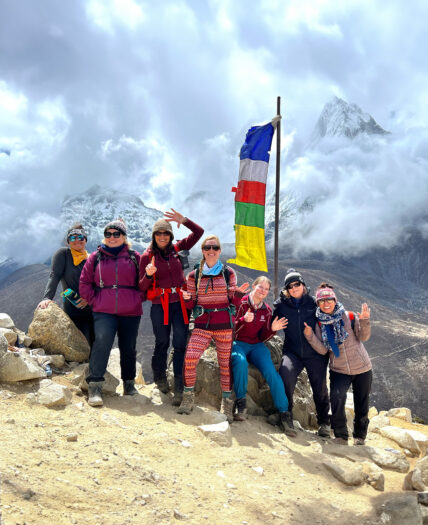
-
Day 9
Dingboche to Lobuche
Valleys and Open Plains
After breakfast, we enjoy a casual hike above Pheriche up to Thugla. The trail snakes back towards the Khumbu valley and continues on a long and slow trek across an elevated route with enormous views. This stretch usually takes about two hours.
After lunch in Thugla, we have a steep climb up the moraine over Thukla Pass to the Everest Climber memorial (984 feet/300 m gain). Thugla to Lobuche involves a steady three hours of trekking beside glass-clear flowing streams in glacier-scraped valleys. We then climb into the open plains above the ice flows sandwiched between the massive mountain ranges.
Included Meals
Breakfast, lunch and dinner
Accommodations
Hotel National Park, Lobuche (or similar)
The Trek
- Trek Route: Dingboche (14,268 feet/4,350 m) to Lobuche (16,210 feet/4,950 m)
- Trek Distance: 7.5 miles (12 km)
- Elevation Gain: 1,942 feet/600 m
- Estimated Hiking Time: 5–6 hours
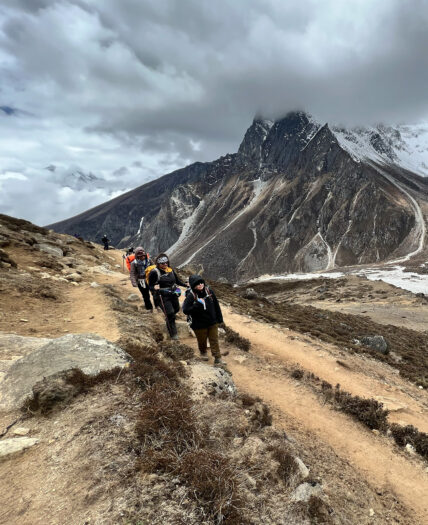
-
Day 10
Lobuche to Base Camp to Gorak Shep
Making Gains
It will be an early bird start to our hike today because we are going ALL THE WAY to Everest Base Camp! Insert goosebumps here! We cross a lot of loose rock and glacial moraine, so we can’t get too distracted! The up and down trail into Gorak Shep will take approximately three hours.
Lunch will be at Gorak Shep, a small settlement that sits on the edge of a unique frozen lakebed that’s covered with sand. It’s another three hours to reach the famed Everest Base Camp. Don’t worry, we will be sure to spend some time enjoying the fever pitch and adrenaline of the camp.
The hike back to Gorak Shep will take two hours. After a solid day of hiking, it’s time to celebrate (or sleep) and recharge. This is an extremely challenging day for most due to the unrelenting elevation gain, altitude and unstable, rough terrain.
Included Meals
Breakfast, lunch and dinner
Accommodations
Hotel Yeti Home in Gorak Shep
The Trek
- Trek Route: Lobuche (elevation: 16,210 feet/4,950 m) to Gorak Shep (16,925 feet/5,160 m) to Base Camp (elevation: 17, 598 feet/5,364 m) and back down to Gorak Shep (16,925 feet/5,160 m)
- Trek Distance: 6.2 miles/10 km
- Elevation Gain: 1,358 feet/414 m
- Elevation Loss: 670 feet/204 m
- Estimated Hiking Time: 7–8 hours
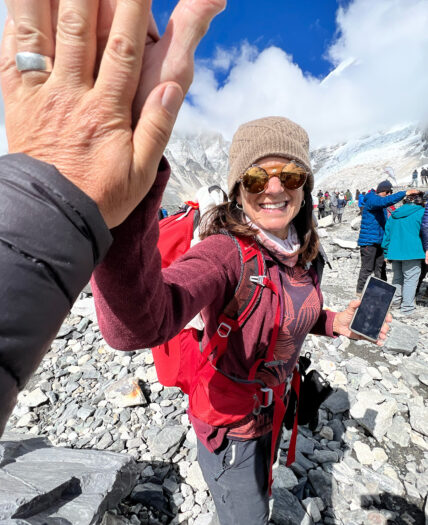
-
Day 11
Kalapathar to Pheriche
Once-in-a-Lifetime Views
This morning we can trek up to Kalapathar or enjoy a lazy and deserved sleep-in. No judgment! For those who wish to hike Kalapathar (18,513 feet/5,643 m) we wake up shockingly early (3 a.m.) but the reward is unmatched—we have front row seats to sunrise over Everest!
This is a difficult three-hour uphill hike of 0.7 miles (1.2 km) with an elevation gain and descent of 1,591 feet (485 m). It’s a tough slog but well worth the challenge for the uninterrupted once-in-a-lifetime views. Upon return to Gorak Shep, we join the sleepyheads for breakfast.
We then hike downhill past the Everest Climbers’ Memorial to Thugla for lunch. In the afternoon, we follow timeworn local tracks that run parallel to glacier-fed streams on the valley floor. We have views of Ama Dablam as we muscle our way to our lodge in Pheriche.
Included Meals
Breakfast, lunch and dinner
Accommodations
Hotel Everest Trekkers in Pheriche
The Trek
- Trek Route: Gorak Shep (elevation: 16,925 feet/5,160 m) to Pheriche (14,336 feet/4,371 m)
- Trek Distance: 8 miles/13 km
- Elevation Loss: 2,588 feet/789 m
- Estimated Hiking Time: 5–6 hours
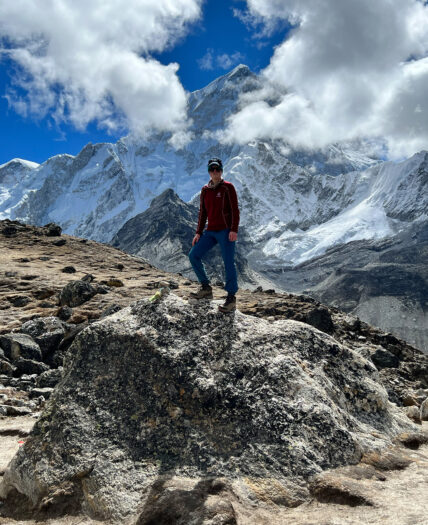
-
Day 12
Pheriche to Pangboche
Downhill All the Way
The hike to Pangboche takes us steadily downhill. The last part of the day we snake along the valley floor following local tracks that run parallel to streams. We have a half day to rest after Base Camp, but if we are feeling energetic and eager to explore more, there is a four-hour (roundtrip) hike towards Amadablam Base Camp that we can knock off after lunch.
If lady luck is on our side, we might be able to spot the stocky blue sheep grazing on the slopes. Native to the high Himalayas, these sheep have a coat color that can appear slate blue. Really, it’s not the elevation getting to us! We can also look for the rainbow plumage of the Danphe pheasant (known as the Himalayan monal), Nepal’s national bird.
Upon arrival in Pangboche, we can check into our rooms, sing in the hot showers and totally mellow out for the evening.
Included Meals
Breakfast, lunch and dinner
Accommodations
Hotel Sonam in Pangboche
The Trek
- Trek Route: Pheriche (elevation: 14,336 feet/4,371 m) to Pangboche (elevation: 13,074 feet/3,985 m)
- Trek Distance: 7 miles (11 km)
- Elevation Gain: 1,444 feet/440 m
- Elevation Loss: 1,266 feet/386 m
- Estimated Hiking Time: 6–7 hours
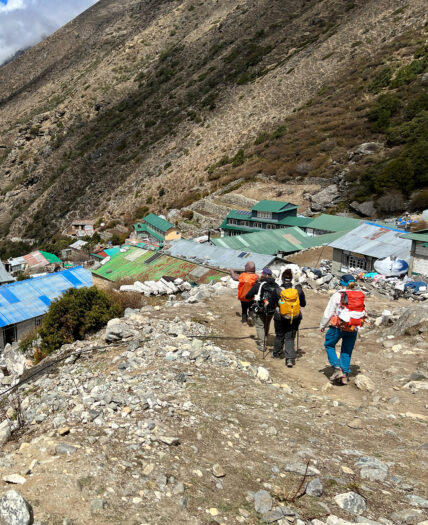
-
Day 13
Pangboche to Mong La
Visiting the Sherpa Village
We awake to tea and views of Tamcherku, Kongde, Ama Dablam and Kantega. After breakfast, we take the high trail to Phortse, Khumbu’s “Sherpa village” where many locals work the tidy potato fields.
After lunch, we drop down to the river and slice through Phortse Thunga as we approach the 1,312 feet (400 m) climb to Mong La. Here, if the weather cooperates, we have a sublime view of Ama Dablam (“Mother’s Necklace”), which sits at an altitude of 22,349 feet (6,812 m).
The long ridges on each side of Ama Dablam appear like the arms of a mother (ama) protecting her child. The hanging glacier has a likeness to the dablam, the traditional double-pendant worn by Sherpa women that reveals pictures of the gods.
With satiated spirits, we gather for dinner and then drift to sleep with a full memory card in our heads!
Included Meals
Breakfast, lunch and dinner
Accommodations
Hotel Hilltop guesthouse in Mong La
The Trek
- Trek Route: Phortse (elevation: 12,500 feet/3,810 m) to Mong La (elevation: 13,021 feet/3,970 m)
- Trek Distance: 1.8 miles/3 km
- Elevation Gain: 1,312 feet/400 m
- Estimated Hiking Time: 4–5 hours
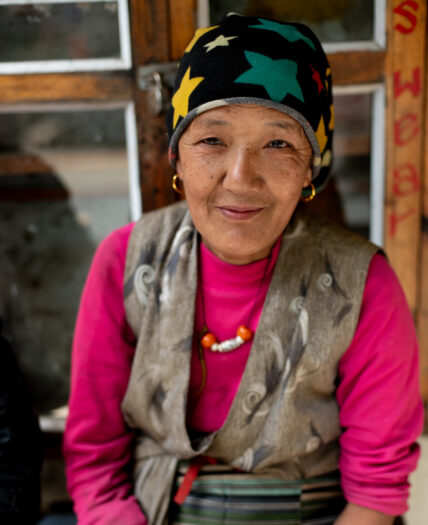
-
Day 14
Mong La to Monjo
We’ve Come a Long Way
We have breakfast and 360-degree views of all the peaks we’ve seen for the last 10 days. Today is our last day to swallow up every bit of the Himalayas that surround us! When we reach Namche Bazaar we stop for lunch and reminisce about how far we’ve come.
Recharged, we have a steep walk down Namche hill to the Hillary suspension bridge. We’ll pass resilient dzos struggling uphill with supplies and smiling trekkers heading in the opposite direction with their hearts and dreams on their GORE-TEX sleeves.
We were that same smiley group, full of anticipation and nerves, just a week ago! It’s important to maintain our pace and be mindful of the slippery gravel path as we follow the now-familiar “Milky White” or Dudh Koshi river. We arrive in Monjo for a celebratory dinner and another rock solid sleep.
Included Meals
Breakfast, lunch and dinner
Accommodations
Monjo Guest House in Monjo
The Trek
- Trek Route: Mong La (elevation: 13,021 feet/3,970 m) to Monjo (elevation: 9,186 feet/2,800 m)
- Trek Distance: 6.8 miles/11 km
- Elevation Loss: 3,838 feet/ 1,170 m
- Estimated Hiking Time: 6–7 hours
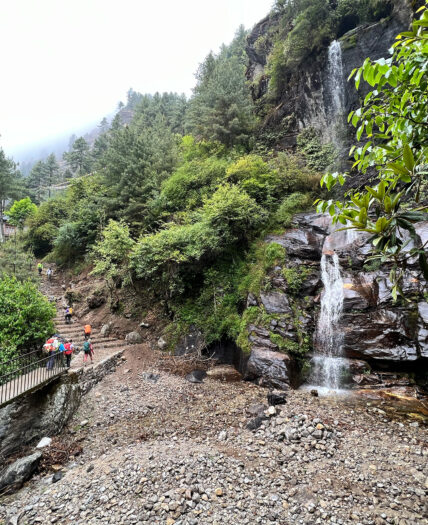
-
Day 15
Monjo to Lukla
One Last Push
We continue on today, rejuvenated after a healing sleep at low altitude. We pass through tiny mountain villages, crossing the final suspension bridges that lead us back to Lukla.
At Hotel Buddha Lodge in Lukla, we check into our rooms for a quick reboot. Depending on our arrival time, there might be free time to explore the local shops or slug back a well-deserved Sherpa Himalayan Red or signature Everest beer. Seems mandatory, right?
In the evening, we have dinner together and have the opportunity to thank everyone who has supported our unforgettable successful trek to Everest Base Camp!
Included Meals
Breakfast, lunch and dinner
Accommodations
Hotel Buddha Lodge in Lukla
The Trek
- Trek Route: Monjo (elevation: 9,186 feet/2,800 m) to Lukla (elevation: 9,186 feet/2,880 m)
- Trek Distance: 7.4 miles/12 km
- Elevation Loss: About 623 feet/190 m
- Elevation Gain: About 885 feet/270 m
- Estimated Hiking Time: 4–5 hours
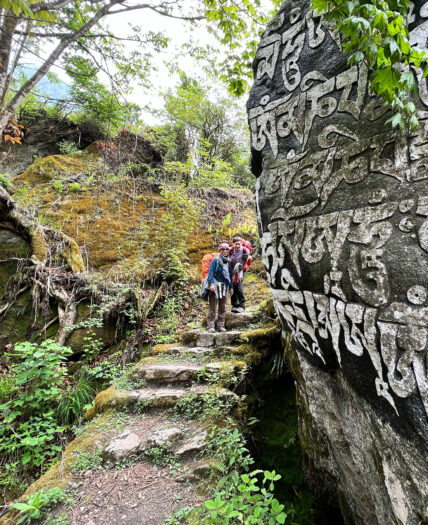
-
Day 16
Lukla to Kathmandu
Take Off
We’ll plan to be ready for takeoff at the Lukla airport by 6 a.m. Our group is scheduled for the first morning flight back to Ramechap, where we’ll pick up our left luggage and then head back towards the buzz of Kathmandu; however, Lukla is notorious for flight delays. If our flights are delayed or canceled due to high winds and the notorious mountain weather, we will have the day to explore Lukla or relax at the hotel, so it’s really win-win!
Included Meals
Breakfast, lunch and dinner
Accommodations
Lodge in Lukla or The Address Hotel
Travel
Approximately 35 minutes (plane)
3 hours driving (Ramechap to Kathmandu)
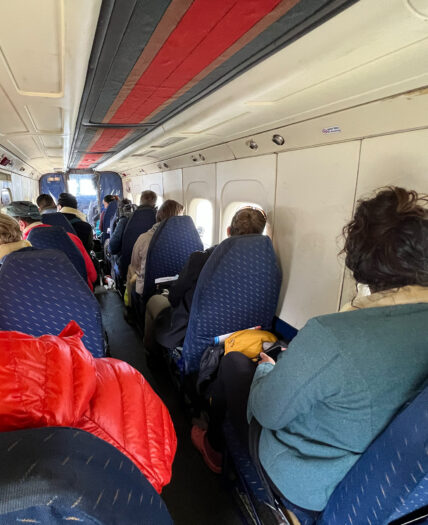
-
Day 17
Kathmandu
Flex Day
This is a built-in flex day in case of inclement weather in Lukla and also the perfect opportunity to relax and take in Pashupatinath now that we have conquered the Base Camp!
We can visit the Pashupatinath Temple, a sacred temple and cremation site where the last rites of Hindu are performed. It’s a designated UNESCO World Heritage Site and the ceremonial cremations are powerful to witness.
Our guide will take us across the river where we can quietly observe them from the vantage point on the hill.
Today’s suggested soundtrack: “Ain’t No Mountain High Enough” by Marvin Gaye.
Included Meals
Breakfast and dinner
Accommodations
The Address Hotel
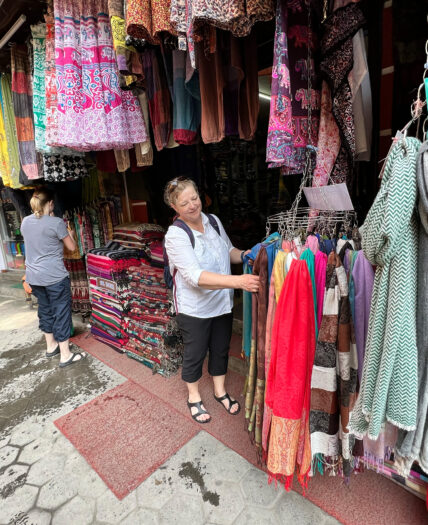
-
Day 18
Kathmandu
Departure
We gather for our last breakfast together and reminisce about all that we have accomplished together.
Please book your departure flights for after 12 p.m. today. Note: the airport shuttle to (KTM) for departing flights is included.
As you reach cruising altitude, let the valleys and peaks below remind you of the amazing goal you achieved with your crew of fearless Wild Women. You trekked to Everest Base Camp! You are a legend! Some people move mountains. Some people make mountains out of molehills. You climbed one!
Included Meals
Breakfast
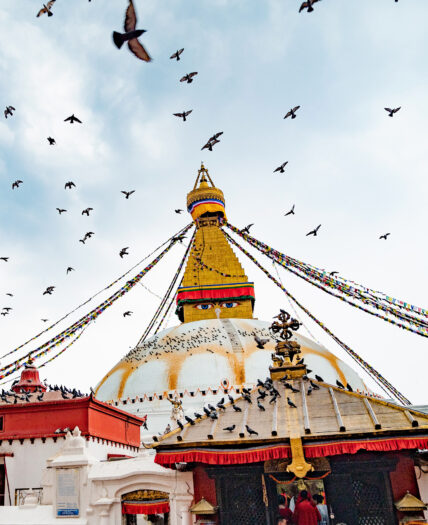
Take a Deeper Dive
Want all the details in one handy package? Download the full itinerary here.
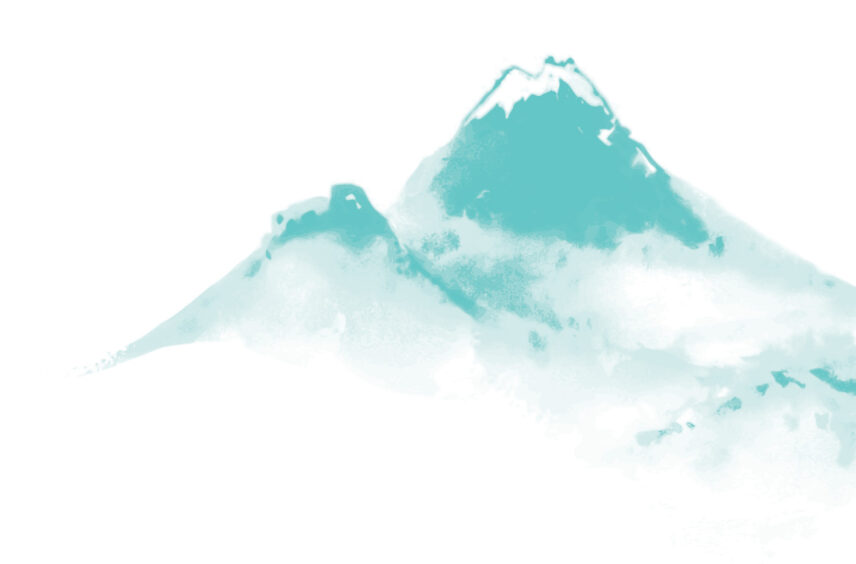
What’s Included
- Airport transfers for arrival and departure
- All ground transportation as outlined in the itinerary
- Three to four nights in Kathmandu in a 3-star hotel
- 12–13 nights in Nepalese mountain lodges during the trek (unheated twin rooms, shared bathrooms with squat or western toilets), shared showers (solar or propane-heated hot water at an additional cost), power and Wifi available (for an additional fee)
- -4°F/-20°C sleeping bag for mountain lodge stays
- Breakfast, lunch, and dinner from Day 2 to Day 16, breakfast ONLY on Days 17 and 18
- One gallon (four liters) of filtered water per day (per person), hot drinks at each meal and 33.8 oz (one liter) of hot water before bed
- An experienced English-speaking female trek guide and city tour guide plus two male assistant guides
- One male porter per every two women (including their daily wages, insurance, equipment, food and lodging)
- Sagarmatha National Park permit, TIMS permit and PRM fees (Pasang Lhamu Rural Municipality)
- Return domestic airfare Kathmandu–Lukla
- Wild Women Expeditions Trek duffel bag
Please Note:
Each woman must have $650 USD available in cash (or credit card) for the helicopter in/out of Lukla in case of airline delays/cancellations so the group can maintain the scheduled itinerary.
All applicable taxes are included in the trip price.
Optional single private room upgrade (in Kathmandu only), subject to availability.
Itineraries may be subject to change without notice due to weather and other environmental conditions. Please review our Booking Terms.

Trip Details
Know Before You Go
Click HERE for all of the logistical details you’ll need to know prior to departure—including the packing list, arrival and departure details and suggested tipping information.
This trip starts in Kathmandu, Nepal (airport code: KTM), and finishes in Kathmandu, Nepal (airport code: KTM).
Physical Fitness Level
This is no walk in the park! You must commit to a serious and dedicated training program prior to this trip. Our Adventure Experts can help you with suggested plans and resources to ensure that you are in optimal condition and prepared for this adventure.
Evacuation Procedure
In the unlikely event that a group member must descend the mountain due to altitude sickness, illness or injury, trek staff will accompany them down the trail to lower elevation and support their return to Kathmandu. Provisions are available for a pony/horse ride (non-severe cases) or a helicopter ride (only for severe cases) to decrease the altitude level. We will be able to designate the trekking guides and porters for the mid-travel departures.
Guides will be in constant contact with the office in Kathmandu and in case of emergency, quick response is possible. The arrangement of the emergency evacuation by any means is the responsibility of Peak Endeavour Nepal Trekking’s guides and porters.
Once the group member is down off the trail, they will be accompanied to the hospital and later returned to the hotel. Extra nights off the trail are at the group member’s expense, as are meals, bottled water and any other items or excursions during this time as well as any additional fees associated with evacuation such as helicopter rescue.
The group member can then choose:
- To remain in Kathmandu and await the group’s return.
- To depart anytime.
In either case, the Wild Women Expeditions guide and office staff and the local partner/guide must be notified of their decision.
*Please note: trip interruption insurance is required in case of flight and/or helicopter delays from Lukla to Kathmandu. We cannot guarantee the day or time of our return flight to Lukla. Trip interruption must cover the cost of rescheduling your flights should you miss your originally planned departure from Kathmandu.
Reminder: You must have access to $650 US for the helicopter in/out of Lukla in case of airline delays/cancellations so the group can maintain the scheduled itinerary. Credit card and/or cash is recommended.
A Typical Day: What to Expect
Mornings will be early, but night owls are welcome! Before breakfast, you will be required to repack your gear into a trek duffel bag, which
will then be transported by the porters and not available to access until you reach your next accommodation that afternoon/evening.
After a simple breakfast (though you may not have your usual appetite due to the altitude), we are usually on the trail between 7:30–8 a.m. depending upon the duration, challenge and nature of the day’s walk. We will walk for around 3–4 hours and then generally break for lunch for about one hour. Some of our staff will walk ahead and select a suitable and usually scenic place to stop. The afternoon walk is usually a little shorter and we try to reach our next accommodation by around 3:30–4:30 p.m. Once we arrive, a nourishing and rejuvenating afternoon tea will be prepared. From the time your tea is steeped until dinner is served, there is free time to rest, journal, doodle, massage your feet or explore the surrounding area.
Dinner is typically served between 6–7 p.m. Trekking evenings afford some of the best memories of your trek, whether it’s simply swapping stories, playing cards, chatting with the crew or joining in some impromptu singing and dancing with the locals. Much of the enjoyment of an expedition is in the journey—you’ll see!
Learn More: Watch the Webinar
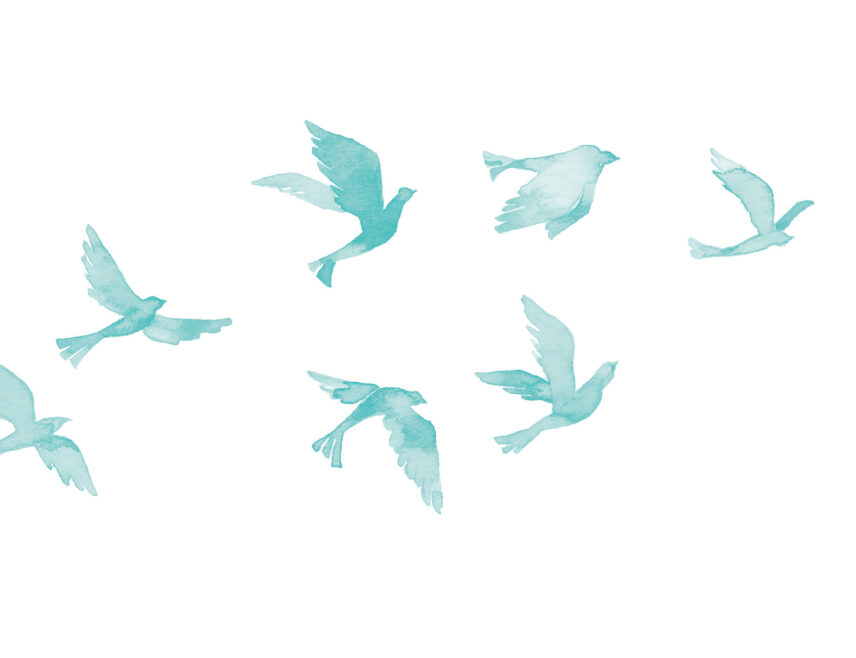
How We Support You
Ready for a big adventure? We’re in it together. On this trip, we hike about six to eight hours per day for 13 days and reach impressive altitudes. Yes, it’s a challenge, but you’re never alone. Like thousands of women before you, you’ll draw on strength you didn’t know you had and come out feeling like the goddess you are.
Still have questions or concerns? Let’s talk about it.
What the Trip Entails
This is an active adventure. We would like you to be comfortable with the following:
- Hiking over rough, uneven terrain and very rocky terrain for an average of 6–8 hours per day for 13 days, covering 38.58 miles (62 km) one way, which is 77.16 miles (124 km) return
- Climbing uphill, gaining 200–900 meters every day for 8 days and descending downhill (200–900 meters) every day for 5 days on the return
- Carrying a 20–30L daypack weighing 10 lbs (5 kg), every day for 13 days
- Hiking at altitude (above 10,000 feet/3000 m)
- Flying in small airplanes (Twin otter) or helicopters and landing on mountain runways
- Sleeping in very basic accommodations (unheated, shared sleeping rooms and shared bathrooms with squat toilets)
- Be prepared for seriously strenuous physical activity!
- Physical Rating: Challenging (Serious fitness level required. Trips are the most physically challenging with approximately 5 to 10 hours of physical activity each day. These trips require a high degree of fitness and even if you exercise regularly, they typically will require more specific conditioning and a specialized training routine depending on the trip.)
